|
SNAP Library 2.2, Developer Reference
2014-03-11 19:15:55
SNAP, a general purpose, high performance system for analysis and manipulation of large networks
|
|
SNAP Library 2.2, Developer Reference
2014-03-11 19:15:55
SNAP, a general purpose, high performance system for analysis and manipulation of large networks
|
#include <cascdynetinf.h>
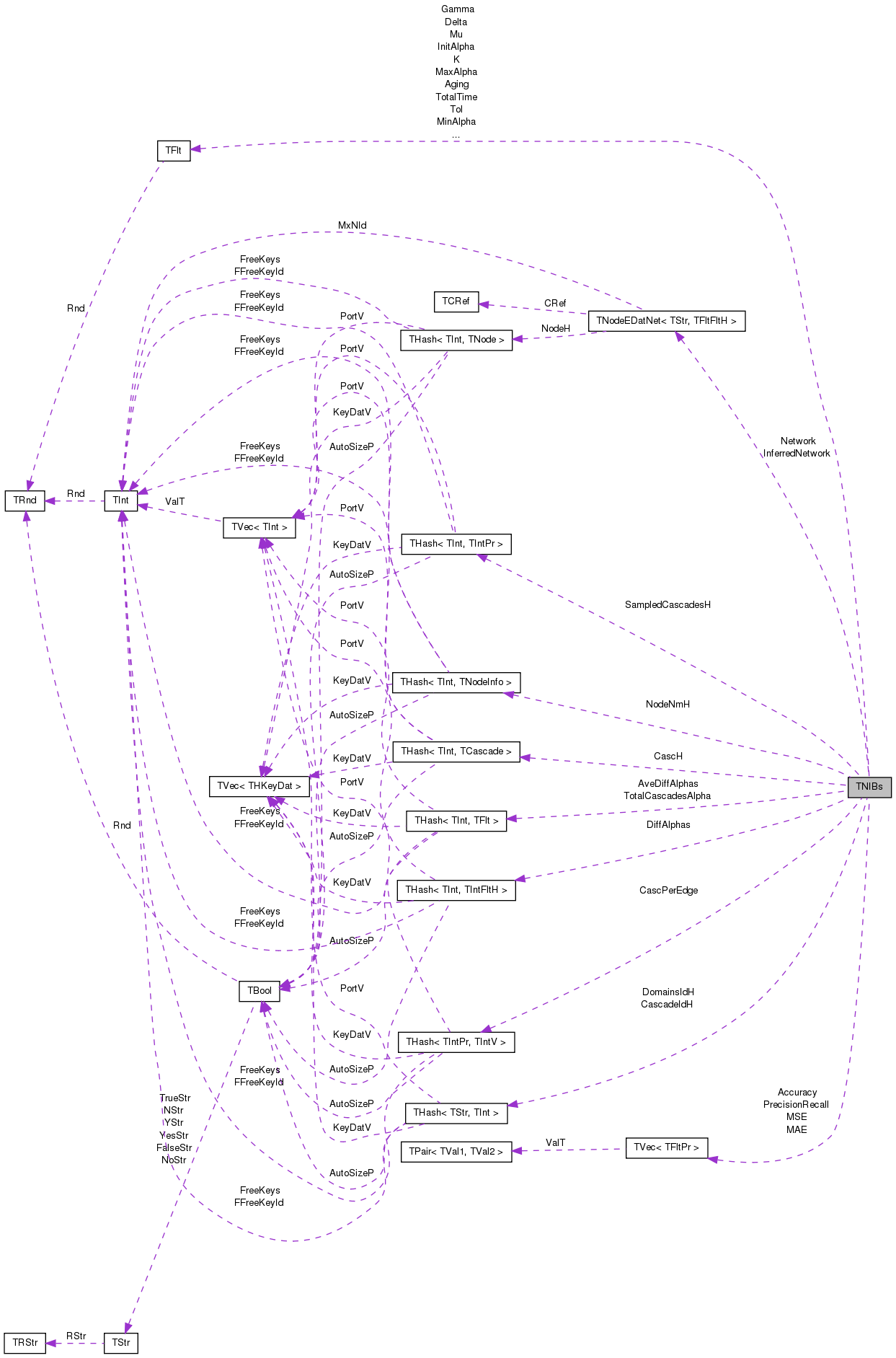
Public Member Functions | |
| TNIBs () | |
| TNIBs (TSIn &SIn) | |
| void | Save (TSOut &SOut) const |
| void | LoadCascadesTxt (TSIn &SIn) |
| void | LoadGroundTruthTxt (TSIn &SIn) |
| void | LoadGroundTruthNodesTxt (TSIn &SIn) |
| void | LoadInferredTxt (TSIn &SIn) |
| void | LoadInferredNodesTxt (TSIn &SIn) |
| void | SetTotalTime (const float &tt) |
| void | SetModel (const TModel &model) |
| void | SetWindow (const double &window) |
| void | SetDelta (const double &delta) |
| void | SetK (const double &k) |
| void | SetGamma (const double &gamma) |
| void | SetAging (const double &aging) |
| void | SetRegularizer (const TRegularizer ®) |
| void | SetMu (const double &mu) |
| void | SetTolerance (const double &tol) |
| void | SetMaxAlpha (const double &ma) |
| void | SetMinAlpha (const double &ma) |
| void | SetInitAlpha (const double &ia) |
| void | AddCasc (const TStr &CascStr, const TModel &Model=EXP) |
| void | AddCasc (const TCascade &Cascade) |
| void | AddCasc (const TIntFltH &Cascade, const int &CId=-1, const TModel &Model=EXP) |
| void | GenCascade (TCascade &C) |
| bool | IsCascade (int c) |
| TCascade & | GetCasc (int c) |
| int | GetCascs () |
| int | GetCascadeId (const TStr &Cascade) |
| int | GetNodes () |
| void | AddNodeNm (const int &NId, const TNodeInfo &Info) |
| TStr | GetNodeNm (const int &NId) const |
| TNodeInfo | GetNodeInfo (const int &NId) const |
| bool | IsNodeNm (const int &NId) const |
| void | SortNodeNmByVol (const bool &asc=false) |
| void | AddDomainNm (const TStr &Domain, const int &DomainId=-1) |
| bool | IsDomainNm (const TStr &Domain) const |
| int | GetDomainId (const TStr &Domain) |
| void | GetGroundTruthGraphAtT (const double &Step, PNGraph &GraphAtT) |
| void | GetGroundTruthNetworkAtT (const double &Step, PStrFltNEDNet &NetworkAtT) |
| void | GetInferredGraphAtT (const double &Step, PNGraph &GraphAtT) |
| void | GetInferredNetworkAtT (const double &Step, PStrFltNEDNet &NetworkAtT) |
| void | Reset () |
| void | Init (const TFltV &Steps) |
| void | SG (const int &NId, const int &Iters, const TFltV &Steps, const TSampling &Sampling, const TStr &ParamSampling=TStr(""), const bool &PlotPerformance=false) |
| void | BSG (const int &NId, const int &Iters, const TFltV &Steps, const int &BatchLen, const TSampling &Sampling, const TStr &ParamSampling=TStr(""), const bool &PlotPerformance=false) |
| void | FG (const int &NId, const int &Iters, const TFltV &Steps) |
| void | UpdateDiff (const TOptMethod &OptMethod, const int &NId, TCascade &Cascade, TIntPrV &AlphasToUpdate, const double &CurrentTime=TFlt::Mx) |
| void | find_C (int t, TFltV &x, TFltVV &C, const int &k, const double &s, const double &gamma, const double &T) |
| void | find_min_state (TFltVV &C, TIntV &states, const int &k, const double &s, const double &gamma, const double &T) |
| void | LabelBurstAutomaton (const int &SrcId, const int &DstId, TIntV &state_labels, TFltV &state_times, const bool &inferred=false, const int &k=5, const double &s=2.0, const double &gamma=1.0, const TSecTm &MinTime=TSecTm(), const TSecTm &MaxTime=TSecTm()) |
| void | ComputePerformanceNId (const int &NId, const int &Step, const TFltV &Steps) |
| void | SaveInferredPajek (const TStr &OutFNm, const double &Step, const TIntV &NIdV=TIntV()) |
| void | SaveInferred (const TStr &OutFNm, const TIntV &NIdV=TIntV()) |
| void | SaveInferred (const TStr &OutFNm, const double &Step, const TIntV &NIdV=TIntV()) |
| void | SaveInferredEdges (const TStr &OutFNm) |
| void | SaveGroundTruthPajek (const TStr &OutFNm, const double &Step) |
| void | SaveGroundTruth (const TStr &OutFNm) |
| void | SaveSites (const TStr &OutFNm, const TIntFltVH &CascadesPerNode=TIntFltVH()) |
| void | SaveCascades (const TStr &OutFNm) |
Public Attributes | |
| THash< TInt, TCascade > | CascH |
| THash< TInt, TNodeInfo > | NodeNmH |
| TStrIntH | DomainsIdH |
| TStrIntH | CascadeIdH |
| THash< TIntPr, TIntV > | CascPerEdge |
| TStrFltFltHNEDNet | Network |
| TModel | Model |
| TFlt | Window |
| TFlt | TotalTime |
| TFlt | Delta |
| TFlt | K |
| TFlt | Gamma |
| TFlt | Mu |
| TFlt | Aging |
| TRegularizer | Regularizer |
| TFlt | Tol |
| TFlt | MaxAlpha |
| TFlt | MinAlpha |
| TFlt | InitAlpha |
| TStrFltFltHNEDNet | InferredNetwork |
| TIntFltH | TotalCascadesAlpha |
| TIntFltH | AveDiffAlphas |
| THash< TInt, TIntFltH > | DiffAlphas |
| TIntIntPrH | SampledCascadesH |
| TFltPrV | PrecisionRecall |
| TFltPrV | Accuracy |
| TFltPrV | MAE |
| TFltPrV | MSE |
Definition at line 130 of file cascdynetinf.h.
| TNIBs::TNIBs | ( | ) | [inline] |
Definition at line 173 of file cascdynetinf.h.
{ }
| TNIBs::TNIBs | ( | TSIn & | SIn | ) | [inline] |
Definition at line 174 of file cascdynetinf.h.
: CascH(SIn), NodeNmH(SIn), CascPerEdge(SIn), InferredNetwork(SIn) { Model = EXP; }
| void TNIBs::AddCasc | ( | const TStr & | CascStr, |
| const TModel & | Model = EXP |
||
| ) |
Definition at line 147 of file cascdynetinf.cpp.
References TCascade::Add(), CascH, GetNodeInfo(), THash< TKey, TDat, THashFunc >::Len(), TVec< TVal, TSizeTy >::Len(), TCascade::Sort(), TStr::SplitOnAllCh(), and TNodeInfo::Vol.
Referenced by AddCasc(), and LoadCascadesTxt().
{
int CId = CascH.Len();
// support cascade id if any
TStrV FieldsV; CascStr.SplitOnAllCh(';', FieldsV);
if (FieldsV.Len()==2) { CId = FieldsV[0].GetInt(); }
// read nodes
TStrV NIdV; FieldsV[FieldsV.Len()-1].SplitOnAllCh(',', NIdV);
TCascade C(CId, Model);
for (int i = 0; i < NIdV.Len(); i+=2) {
int NId;
double Tm;
NId = NIdV[i].GetInt();
Tm = NIdV[i+1].GetFlt();
GetNodeInfo(NId).Vol = GetNodeInfo(NId).Vol + 1;
C.Add(NId, Tm);
}
C.Sort();
AddCasc(C);
}
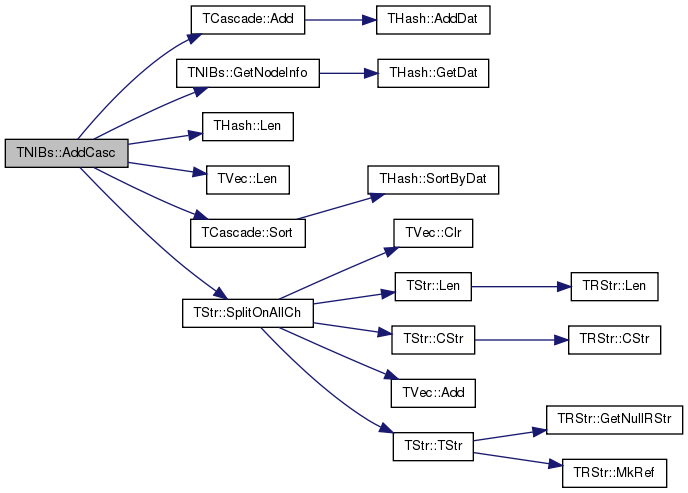

| void TNIBs::AddCasc | ( | const TCascade & | Cascade | ) | [inline] |
Definition at line 205 of file cascdynetinf.h.
References THash< TKey, TDat, THashFunc >::AddDat(), CascH, and TCascade::CId.

| void TNIBs::AddCasc | ( | const TIntFltH & | Cascade, |
| const int & | CId = -1, |
||
| const TModel & | Model = EXP |
||
| ) |
Definition at line 170 of file cascdynetinf.cpp.
References TCascade::Add(), AddCasc(), THash< TKey, TDat, THashFunc >::BegI(), THash< TKey, TDat, THashFunc >::EndI(), GetNodeInfo(), and TCascade::Sort().
{
TCascade C(CId, Model);
for (TIntFltH::TIter NI = Cascade.BegI(); NI < Cascade.EndI(); NI++) {
GetNodeInfo(NI.GetKey()).Vol = GetNodeInfo(NI.GetKey()).Vol + 1;
C.Add(NI.GetKey(), NI.GetDat());
}
C.Sort();
AddCasc(C);
}
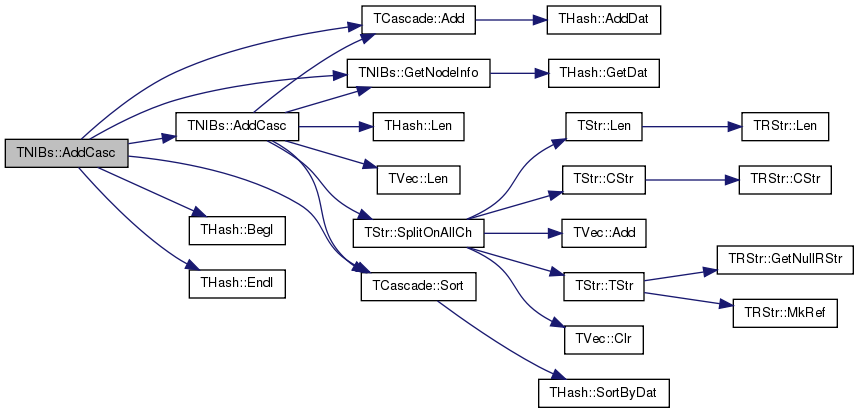
| void TNIBs::AddDomainNm | ( | const TStr & | Domain, |
| const int & | DomainId = -1 |
||
| ) | [inline] |
Definition at line 222 of file cascdynetinf.h.
References THash< TKey, TDat, THashFunc >::AddDat(), DomainsIdH, and THash< TKey, TDat, THashFunc >::Len().
{ DomainsIdH.AddDat(Domain) = TInt(DomainId==-1? DomainsIdH.Len() : DomainId); }

| void TNIBs::AddNodeNm | ( | const int & | NId, |
| const TNodeInfo & | Info | ||
| ) | [inline] |
Definition at line 215 of file cascdynetinf.h.
References THash< TKey, TDat, THashFunc >::AddDat(), and NodeNmH.
Referenced by LoadCascadesTxt(), LoadGroundTruthNodesTxt(), LoadGroundTruthTxt(), LoadInferredNodesTxt(), and LoadInferredTxt().

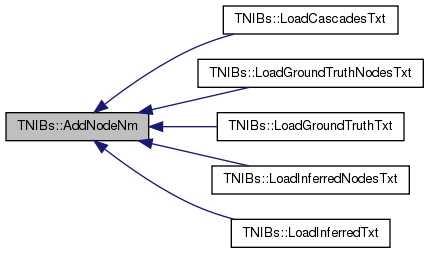
| void TNIBs::BSG | ( | const int & | NId, |
| const int & | Iters, | ||
| const TFltV & | Steps, | ||
| const int & | BatchLen, | ||
| const TSampling & | Sampling, | ||
| const TStr & | ParamSampling = TStr(""), |
||
| const bool & | PlotPerformance = false |
||
| ) |
Definition at line 501 of file cascdynetinf.cpp.
References THash< TKey, TDat, THashFunc >::AddDat(), AveDiffAlphas, TNodeEDatNet< TNodeData, TEdgeData >::BegEI(), CascH, THash< TKey, TDat, THashFunc >::Clr(), ComputePerformanceNId(), TNodeEDatNet< TNodeData, TEdgeData >::EndEI(), EXP_SAMPLING, Gamma, THash< TKey, TDat, THashFunc >::GetDat(), TNodeEDatNet< TNodeData, TEdgeData >::GetEDat(), THash< TKey, TDat, THashFunc >::GetKey(), TNodeEDatNet< TNodeData, TEdgeData >::GetNodes(), TRnd::GetUniDevInt(), InferredNetwork, TNodeEDatNet< TNodeData, TEdgeData >::IsEdge(), THash< TKey, TDat, THashFunc >::IsKey(), THash< TKey, TDat, THashFunc >::Len(), TVec< TVal, TSizeTy >::Len(), MaxAlpha, Mu, OBSG, RAY_SAMPLING, Regularizer, Reset(), TInt::Rnd, TFlt::Rnd, THash< TKey, TDat, THashFunc >::SortByDat(), TStr::SplitOnAllCh(), Tol, UNIF_SAMPLING, UpdateDiff(), WIN_EXP_SAMPLING, and WIN_SAMPLING.
{
bool verbose = false;
int currentCascade = -1;
TIntIntH SampledCascades;
TStrV ParamSamplingV; ParamSampling.SplitOnAllCh(';', ParamSamplingV);
Reset();
printf("Node %d (|A|: %d)\n", NId, InferredNetwork.GetNodes());
// traverse through all times (except 0.0; we use 0.0 to compute mse/mae since the inference is delayed)
for (int t=1; t<Steps.Len(); t++) {
// find cascades whose two first infections are earlier than Steps[t]
TIntFltH CascadesIdx;
int num_infections = 0;
for (int i = 0; i < CascH.Len(); i++) {
if (CascH[i].LenBeforeT(Steps[t]) > 1 &&
( (Sampling!=WIN_SAMPLING && Sampling!=WIN_EXP_SAMPLING) ||
(Sampling==WIN_SAMPLING && (Steps[t]-CascH[i].GetMinTm()) <= ParamSamplingV[0].GetFlt()) ||
(Sampling==WIN_EXP_SAMPLING && (Steps[t]-CascH[i].GetMinTm()) <= ParamSamplingV[0].GetFlt()) )) {
num_infections += CascH[i].LenBeforeT(Steps[t]);
CascadesIdx.AddDat(i) = CascH[i].GetMinTm();
}
}
// if there are not recorded cascades by Steps[t], continue
if (CascadesIdx.Len() == 0) {
printf("WARNING: No cascades recorded by %f!\n", Steps[t].Val);
if (PlotPerformance) { ComputePerformanceNId(NId, t, Steps); }
continue;
}
printf("Solving step %f (%d cascades, %d infections)\n", Steps[t].Val,
CascadesIdx.Len(), num_infections);
// sort cascade from most recent to least recent
CascadesIdx.SortByDat(false);
// sampling cascades with no replacement
for (int i=0; i < Iters; i++) {
// alphas to update
TIntPrV AlphasToUpdate;
// delete average gradients
AveDiffAlphas.Clr();
// use all cascades for the average gradient
for (int c=0; c<BatchLen; c++) {
switch (Sampling) {
case UNIF_SAMPLING:
currentCascade = TInt::Rnd.GetUniDevInt(CascadesIdx.Len());
break;
case WIN_SAMPLING:
currentCascade = TInt::Rnd.GetUniDevInt(CascadesIdx.Len());
break;
case EXP_SAMPLING:
do {
currentCascade = (int)TFlt::Rnd.GetExpDev(ParamSamplingV[0].GetFlt());
} while (currentCascade > CascadesIdx.Len()-1);
break;
case WIN_EXP_SAMPLING:
do {
currentCascade = (int)TFlt::Rnd.GetExpDev(ParamSamplingV[1].GetFlt());
} while (currentCascade > CascadesIdx.Len()-1);
break;
case RAY_SAMPLING:
do {
currentCascade = (int)TFlt::Rnd.GetRayleigh(ParamSamplingV[0].GetFlt());
} while (currentCascade > CascadesIdx.Len()-1);
break;
}
// sampled cascade
TCascade &Cascade = CascH[CascadesIdx.GetKey(currentCascade)];
if (!SampledCascades.IsKey(currentCascade)) { SampledCascades.AddDat(currentCascade) = 0; }
SampledCascades.GetDat(currentCascade)++;
// update gradient and alpha's
UpdateDiff(OBSG, NId, Cascade, AlphasToUpdate, Steps[t]);
}
// update alpha's
for (int j=0; j<AlphasToUpdate.Len(); j++) {
if (InferredNetwork.IsEdge(AlphasToUpdate[j].Val1, AlphasToUpdate[j].Val2) &&
InferredNetwork.GetEDat(AlphasToUpdate[j].Val1, AlphasToUpdate[j].Val2).IsKey(Steps[t])) {
switch (Regularizer) {
case 0:
InferredNetwork.GetEDat(AlphasToUpdate[j].Val1, AlphasToUpdate[j].Val2).GetDat(Steps[t]) -=
Gamma * (1.0/(double)BatchLen) * AveDiffAlphas.GetDat(AlphasToUpdate[j].Val1);
case 1:
InferredNetwork.GetEDat(AlphasToUpdate[j].Val1, AlphasToUpdate[j].Val2).GetDat(Steps[t]) =
InferredNetwork.GetEDat(AlphasToUpdate[j].Val1, AlphasToUpdate[j].Val2).GetDat(Steps[t])*(1.0-Mu*Gamma/(double)BatchLen)
- Gamma * (1.0/(double)BatchLen) * AveDiffAlphas.GetDat(AlphasToUpdate[j].Val1);
}
// project into alpha >= 0
if (InferredNetwork.GetEDat(AlphasToUpdate[j].Val1, AlphasToUpdate[j].Val2).GetDat(Steps[t]) < Tol) {
InferredNetwork.GetEDat(AlphasToUpdate[j].Val1, AlphasToUpdate[j].Val2).GetDat(Steps[t]) = Tol;
}
// project into alpha <= MaxAlpha
if (InferredNetwork.GetEDat(AlphasToUpdate[j].Val1, AlphasToUpdate[j].Val2).GetDat(Steps[t]) > MaxAlpha) {
InferredNetwork.GetEDat(AlphasToUpdate[j].Val1, AlphasToUpdate[j].Val2).GetDat(Steps[t]) = MaxAlpha;
}
}
}
// for alphas that did not get updated, copy last alpha value
int unchanged = 0;
for (TStrFltFltHNEDNet::TEdgeI EI = InferredNetwork.BegEI(); EI < InferredNetwork.EndEI(); EI++) {
if (EI().IsKey(Steps[t]) || t == 0 || !EI().IsKey(Steps[t-1])) { continue; }
EI().AddDat(Steps[t]) = EI().GetDat(Steps[t-1]);
unchanged++;
}
if (verbose) { printf("%d unchanged transmission rates updated!\n", unchanged); }
}
printf("%d different cascades have been sampled for step %f!\n", SampledCascades.Len(), Steps[t].Val);
// compute performance on-the-fly for each time step
if (PlotPerformance) { ComputePerformanceNId(NId, t, Steps); }
}
}
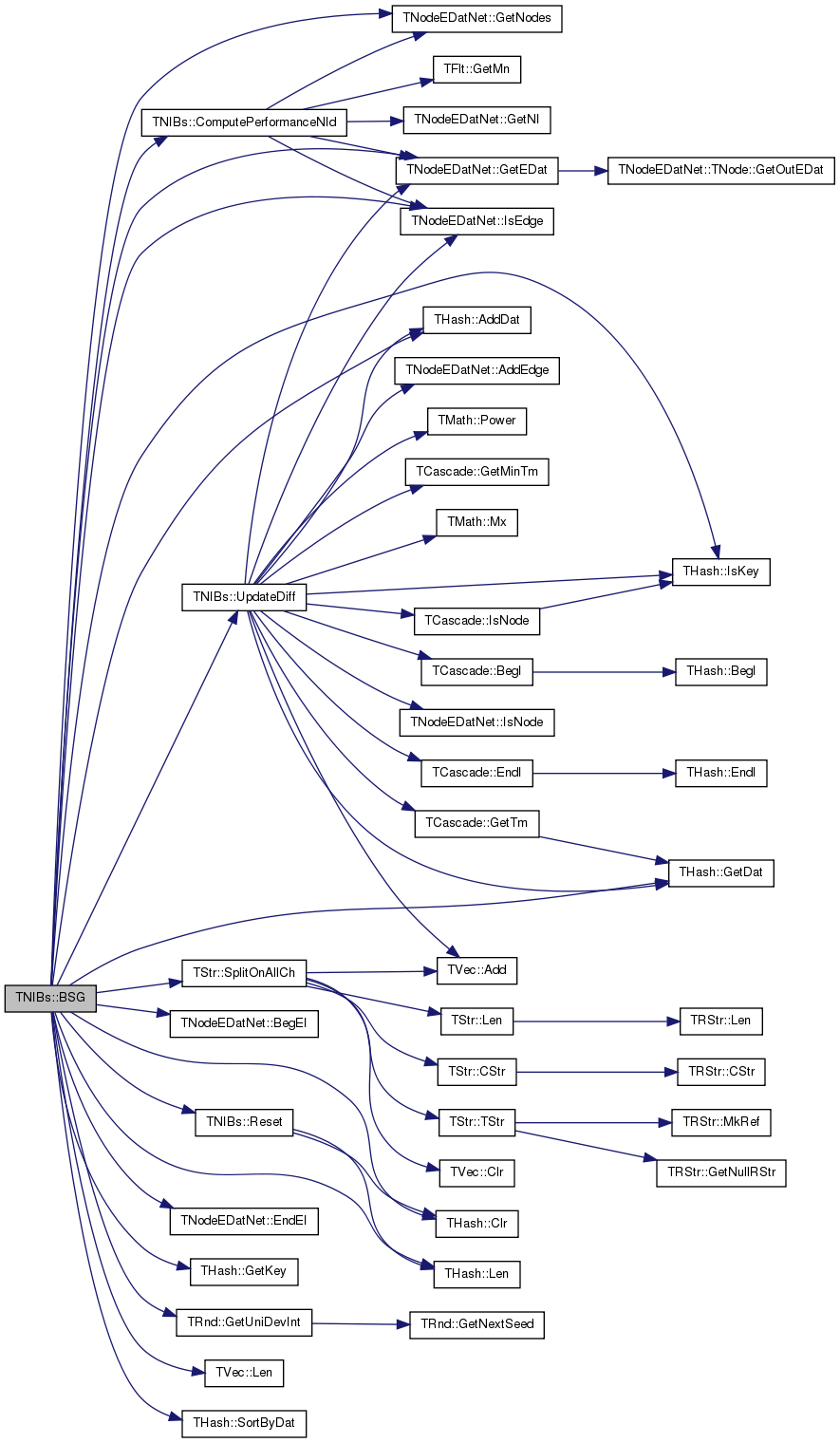
| void TNIBs::ComputePerformanceNId | ( | const int & | NId, |
| const int & | Step, | ||
| const TFltV & | Steps | ||
| ) |
Definition at line 918 of file cascdynetinf.cpp.
References Accuracy, TNodeEDatNet< TNodeData, TEdgeData >::GetEDat(), TFlt::GetMn(), TNodeEDatNet< TNodeData, TEdgeData >::GetNI(), TNodeEDatNet< TNodeData, TEdgeData >::GetNodes(), InferredNetwork, TNodeEDatNet< TNodeData, TEdgeData >::IsEdge(), MAE, MaxAlpha, MinAlpha, MSE, Network, PrecisionRecall, TPair< TVal1, TVal2 >::Val1, and TPair< TVal1, TVal2 >::Val2.
Referenced by BSG(), FG(), and SG().
{
double CurrentMAE = 0.0;
double CurrentMSE = 0.0;
TFltPr CurrentPrecisionRecall(0.0, 0.0);
double CurrentAccD = 0.0;
TStrFltFltHNEDNet::TNodeI NI = InferredNetwork.GetNI(NId);
for (int i=0; i<NI.GetInDeg(); i++) {
double inferredAlpha = InferredNetwork.GetEDat(NI.GetInNId(i), NId).GetDat(Steps[t]);
// we get the true alpha in the previous step (the inferred network contains delayed estimates)
double trueAlpha = 0.0;
if (Network.IsEdge(NI.GetInNId(i), NId) && Network.GetEDat(NI.GetInNId(i), NId).IsKey(Steps[t-1])) { trueAlpha = Network.GetEDat(NI.GetInNId(i), NId).GetDat(Steps[t-1]); }
// accuracy (denominator)
CurrentAccD += (double) (inferredAlpha > MinAlpha);
// precision
CurrentPrecisionRecall.Val2 += (double) (inferredAlpha > MinAlpha && trueAlpha<MinAlpha);
}
NI = Network.GetNI(NId);
int NumEdges = 0;
for (int i=0; i<NI.GetInDeg(); i++) {
TIntPr Pair(NI.GetInNId(i), NId);
// we get the inferred Alpha if any
double inferredAlpha = 0.0;
if (InferredNetwork.IsEdge(NI.GetInNId(i), NId) && InferredNetwork.GetEDat(NI.GetInNId(i), NId).IsKey(Steps[t])) {
inferredAlpha = InferredNetwork.GetEDat(NI.GetInNId(i), NId).GetDat(Steps[t]).Val;
}
// we get the true alpha in the previous step (the inferred network contains delayed estimates)
double trueAlpha = 0.0;
if (Network.GetEDat(NI.GetInNId(i), NId).IsKey(Steps[t-1])) { trueAlpha = Network.GetEDat(NI.GetInNId(i), NId).GetDat(Steps[t-1]); }
// mae
if (trueAlpha > MinAlpha) {
NumEdges++;
CurrentMAE += fabs(trueAlpha - TFlt::GetMn(inferredAlpha, MaxAlpha))/trueAlpha;
}
// mse
CurrentMSE += pow(trueAlpha - TFlt::GetMn(inferredAlpha, MaxAlpha), 2.0);
// recall
CurrentPrecisionRecall.Val1 += (double) (inferredAlpha > MinAlpha && trueAlpha > MinAlpha);
}
if (NumEdges > 0) {
MAE[t-1].Val2 += CurrentMAE / ((double)(NumEdges*Network.GetNodes()));
MSE[t-1].Val2 += CurrentMSE / ((double)(NumEdges*Network.GetNodes()));
PrecisionRecall[t-1].Val1 += CurrentPrecisionRecall.Val1/(double)(NumEdges*Network.GetNodes());
}
if (CurrentAccD > 0) {
PrecisionRecall[t-1].Val2 += (1.0 - CurrentPrecisionRecall.Val2 / CurrentAccD)/(double)Network.GetNodes();
} else {
PrecisionRecall[t-1].Val2 += 1.0/(double)Network.GetNodes();
}
Accuracy[t-1].Val2 = 1.0 - (1.0-PrecisionRecall[t-1].Val2)/(PrecisionRecall[t-1].Val2 * (1.0/PrecisionRecall[t-1].Val2 + 1.0/PrecisionRecall[t-1].Val1)) - (1.0-PrecisionRecall[t-1].Val1)/(PrecisionRecall[t-1].Val1* (1.0/PrecisionRecall[t-1].Val2 + 1.0/PrecisionRecall[t-1].Val1));
}
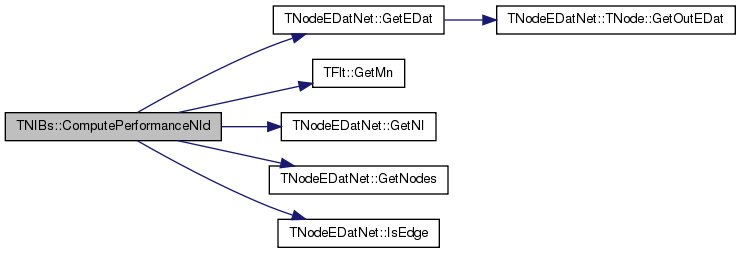

Definition at line 631 of file cascdynetinf.cpp.
References THash< TKey, TDat, THashFunc >::AddDat(), AveDiffAlphas, TNodeEDatNet< TNodeData, TEdgeData >::BegEI(), CascH, THash< TKey, TDat, THashFunc >::Clr(), ComputePerformanceNId(), TNodeEDatNet< TNodeData, TEdgeData >::EndEI(), Gamma, THash< TKey, TDat, THashFunc >::GetDat(), TNodeEDatNet< TNodeData, TEdgeData >::GetEDat(), THash< TKey, TDat, THashFunc >::GetKey(), TNodeEDatNet< TNodeData, TEdgeData >::GetNodes(), InferredNetwork, TNodeEDatNet< TNodeData, TEdgeData >::IsEdge(), THash< TKey, TDat, THashFunc >::Len(), TVec< TVal, TSizeTy >::Len(), MaxAlpha, Mu, OBSG, Regularizer, Reset(), THash< TKey, TDat, THashFunc >::SortByDat(), Tol, and UpdateDiff().
{
bool verbose = false;
Reset();
printf("Node %d (|A|: %d)\n", NId, InferredNetwork.GetNodes());
// traverse through all times
for (int t=1; t<Steps.Len(); t++) {
// find cascades whose two first infections are earlier than Steps[t]
TIntFltH CascadesIdx;
int num_infections = 0;
for (int i=0; i<CascH.Len(); i++) {
if (CascH[i].LenBeforeT(Steps[t]) > 1) {
num_infections += CascH[i].LenBeforeT(Steps[t]);
CascadesIdx.AddDat(i) = CascH[i].GetMinTm();
}
}
// if there are not recorded cascades by Steps[t], continue
if (CascadesIdx.Len()==0) {
printf("WARNING: No cascades recorded by %f!\n", Steps[t].Val);
// ComputePerformance(NId, Tol, t, Steps);
continue;
}
printf("Solving step %f (%d cascades, %d infections)\n", Steps[t].Val, CascadesIdx.Len(), num_infections);
// sort cascade from most recent to least recent
CascadesIdx.SortByDat(false);
// sampling cascades with no replacement
for (int i=0; i < Iters; i++) {
// alphas to update
TIntPrV AlphasToUpdate;
// delete average gradients
AveDiffAlphas.Clr();
// use all cascades for the average gradient
for (int c=0; c<CascadesIdx.Len(); c++) {
// each cascade
TCascade &Cascade = CascH[CascadesIdx.GetKey(c)];
// update gradient and alpha's
UpdateDiff(OBSG, NId, Cascade, AlphasToUpdate, Steps[t]);
}
// update alpha's
for (int j=0; j<AlphasToUpdate.Len(); j++) {
if (InferredNetwork.IsEdge(AlphasToUpdate[j].Val1, AlphasToUpdate[j].Val2) &&
InferredNetwork.GetEDat(AlphasToUpdate[j].Val1, AlphasToUpdate[j].Val2).IsKey(Steps[t])) {
switch (Regularizer) {
case 0:
InferredNetwork.GetEDat(AlphasToUpdate[j].Val1, AlphasToUpdate[j].Val2).GetDat(Steps[t]) -=
Gamma * (1.0/(double)CascadesIdx.Len()) * AveDiffAlphas.GetDat(AlphasToUpdate[j].Val1);
case 1:
InferredNetwork.GetEDat(AlphasToUpdate[j].Val1, AlphasToUpdate[j].Val2).GetDat(Steps[t]) =
InferredNetwork.GetEDat(AlphasToUpdate[j].Val1, AlphasToUpdate[j].Val2).GetDat(Steps[t])*(1.0-Mu*Gamma/(double)CascadesIdx.Len())
- Gamma * (1.0/(double)CascadesIdx.Len()) * AveDiffAlphas.GetDat(AlphasToUpdate[j].Val1);
}
// project into alpha >= 0
if (InferredNetwork.GetEDat(AlphasToUpdate[j].Val1, AlphasToUpdate[j].Val2).GetDat(Steps[t]) < Tol) {
InferredNetwork.GetEDat(AlphasToUpdate[j].Val1, AlphasToUpdate[j].Val2).GetDat(Steps[t]) = Tol;
}
// project into alpha <= MaxAlpha
if (InferredNetwork.GetEDat(AlphasToUpdate[j].Val1, AlphasToUpdate[j].Val2).GetDat(Steps[t]) > MaxAlpha) {
InferredNetwork.GetEDat(AlphasToUpdate[j].Val1, AlphasToUpdate[j].Val2).GetDat(Steps[t]) = MaxAlpha;
}
}
}
// for alphas that did not get updated, copy last alpha value
int unchanged = 0;
for (TStrFltFltHNEDNet::TEdgeI EI = InferredNetwork.BegEI(); EI < InferredNetwork.EndEI(); EI++) {
if (EI().IsKey(Steps[t]) || t == 0 || !EI().IsKey(Steps[t-1])) { continue; }
EI().AddDat(Steps[t]) = EI().GetDat(Steps[t-1]);
unchanged++;
}
if (verbose) { printf("%d unchanged transmission rates updated!\n", unchanged); }
}
// compute performance on-the-fly for each time step
ComputePerformanceNId(NId, t, Steps);
}
}

| void TNIBs::find_C | ( | int | t, |
| TFltV & | x, | ||
| TFltVV & | C, | ||
| const int & | k, | ||
| const double & | s, | ||
| const double & | gamma, | ||
| const double & | T | ||
| ) |
Definition at line 835 of file cascdynetinf.cpp.
References TVec< TVal, TSizeTy >::Len().
Referenced by LabelBurstAutomaton().
{
if ( t >= x.Len() ) return;
if ( t == 0 ){
C = TFltVV( x.Len(), k );
}else{
int n = x.Len() - 1;
for (int j = 0; j < k; j++){
double alpha = ( (x.Len() ) / T ) * pow( s, j );
double term_1 = -log(alpha) + alpha * x[t];
double term_2 = 0;
if ( t == 1 ){
term_2 = j * log(n) * gamma;
}
else{
bool first = false;
for (int l = 0; l < k; l++){
double my_val = C(t-1, l);
if ( j > l ) my_val += (j - l) * log(n) * gamma;
if ( !first || my_val < term_2 ){
term_2 = my_val;
first = true;
}
}
}
C( t, j ) = term_1 + term_2;
}
}
find_C( t + 1, x, C, k, s, gamma, T );
}


| void TNIBs::find_min_state | ( | TFltVV & | C, |
| TIntV & | states, | ||
| const int & | k, | ||
| const double & | s, | ||
| const double & | gamma, | ||
| const double & | T | ||
| ) |
Definition at line 865 of file cascdynetinf.cpp.
References TVVec< TVal >::GetCols(), and TVVec< TVal >::GetRows().
Referenced by LabelBurstAutomaton().
{
states = TIntV( C.GetRows() );
states[0] = 0;
int n = C.GetRows() - 1;
for (int t = C.GetRows() - 1; t > 0; t --){
double best_val = 0;
int best_state = -1;
for (int j = 0; j < C.GetCols(); j++){
double c_state = C( t, j );
if ( t < C.GetRows() - 2 && states[t+1] > j ){
c_state += ( states[t+1] - j ) * gamma * log(n);
}
if ( best_state == -1 || best_val > c_state ){
best_state = j;
best_val = c_state;
}
}
states[t] = best_state;
}
}


| void TNIBs::GenCascade | ( | TCascade & | C | ) |
Definition at line 180 of file cascdynetinf.cpp.
References TCascade::Add(), THash< TKey, TDat, THashFunc >::AddDat(), THash< TKey, TDat, THashFunc >::BegI(), TCascade::Clr(), THash< TKey, TDat, THashFunc >::Clr(), Delta, EXP, THashKeyDatI< TKey, TDat >::GetDat(), THash< TKey, TDat, THashFunc >::GetDat(), TNodeEDatNet< TNodeData, TEdgeData >::GetEDat(), TRnd::GetExpDev(), THashKeyDatI< TKey, TDat >::GetKey(), THash< TKey, TDat, THashFunc >::GetKey(), TFlt::GetMn(), TNodeEDatNet< TNodeData, TEdgeData >::GetNI(), TNodeEDatNet< TNodeData, TEdgeData >::GetNodes(), TRnd::GetPowerDev(), TRnd::GetRayleigh(), TNodeEDatNet< TNodeData, TEdgeData >::GetRndNId(), TRnd::GetUniDev(), IAssert, THash< TKey, TDat, THashFunc >::IsKey(), TCascade::Len(), THash< TKey, TDat, THashFunc >::Len(), Model, Network, POW, TRnd::Randomize(), RAY, TInt::Rnd, TFlt::Rnd, TCascade::Sort(), THash< TKey, TDat, THashFunc >::SortByDat(), TotalTime, TInt::Val, and Window.
{
bool verbose = false;
TIntFltH InfectedNIdH; TIntH InfectedBy;
double GlobalTime, InitTime;
double alpha;
int StartNId;
if (Network.GetNodes() == 0)
return;
// set random seed
TInt::Rnd.Randomize();
while (C.Len() < 2) {
C.Clr();
InfectedNIdH.Clr();
InfectedBy.Clr();
InitTime = TFlt::Rnd.GetUniDev() * TotalTime; // random starting point <TotalTime
GlobalTime = InitTime;
StartNId = Network.GetRndNId();
InfectedNIdH.AddDat(StartNId) = GlobalTime;
while (true) {
// sort by time & get the oldest node that did not run infection
InfectedNIdH.SortByDat(true);
const int& NId = InfectedNIdH.BegI().GetKey();
GlobalTime = InfectedNIdH.BegI().GetDat();
// all the nodes has run infection
if ( GlobalTime >= TFlt::GetMn(TotalTime, InitTime+Window) )
break;
// add current oldest node to the network and set its time
C.Add(NId, GlobalTime);
if (verbose) { printf("GlobalTime:%f, infected node:%d\n", GlobalTime, NId); }
// run infection from the current oldest node
TStrFltFltHNEDNet::TNodeI NI = Network.GetNI(NId);
for (int e = 0; e < NI.GetOutDeg(); e++) {
const int DstNId = NI.GetOutNId(e);
// choose the current tx rate (we assume the most recent tx rate)
TFltFltH& Alphas = Network.GetEDat(NId, DstNId);
for (int j=0; j<Alphas.Len() && Alphas.GetKey(j)<GlobalTime; j++) { alpha = Alphas[j]; }
if (verbose) { printf("GlobalTime:%f, nodes:%d->%d, alpha:%f\n", GlobalTime, NId, DstNId, alpha); }
if (alpha<1e-9) { continue; }
// not infecting the parent
if (InfectedBy.IsKey(NId) && InfectedBy.GetDat(NId).Val == DstNId)
continue;
double sigmaT;
switch (Model) {
case EXP:
// exponential with alpha parameter
sigmaT = TInt::Rnd.GetExpDev(alpha);
break;
case POW:
// power-law with alpha parameter
sigmaT = TInt::Rnd.GetPowerDev(1+alpha);
while (sigmaT < Delta) { sigmaT = Delta*TInt::Rnd.GetPowerDev(1+alpha); }
break;
case RAY:
// rayleigh with alpha parameter
sigmaT = TInt::Rnd.GetRayleigh(1/sqrt(alpha));
break;
default:
sigmaT = 1;
break;
}
IAssert(sigmaT >= 0);
double t1 = TFlt::GetMn(GlobalTime + sigmaT, TFlt::GetMn(InitTime+Window, TotalTime));
if (InfectedNIdH.IsKey(DstNId)) {
double t2 = InfectedNIdH.GetDat(DstNId);
if ( t2 > t1 && t2 < TFlt::GetMn(InitTime+Window, TotalTime)) {
InfectedNIdH.GetDat(DstNId) = t1;
InfectedBy.GetDat(DstNId) = NId;
}
} else {
InfectedNIdH.AddDat(DstNId) = t1;
InfectedBy.AddDat(DstNId) = NId;
}
}
// we cannot delete key (otherwise, we cannot sort), so we assign a big time (InitTime + window cut-off)
InfectedNIdH.GetDat(NId) = TFlt::GetMn(InitTime+Window, TotalTime);
}
}
C.Sort();
}

| TCascade& TNIBs::GetCasc | ( | int | c | ) | [inline] |
Definition at line 209 of file cascdynetinf.h.
References CascH, and THash< TKey, TDat, THashFunc >::GetDat().

| int TNIBs::GetCascadeId | ( | const TStr & | Cascade | ) | [inline] |
Definition at line 211 of file cascdynetinf.h.
References CascadeIdH, and THash< TKey, TDat, THashFunc >::GetDat().
{ return CascadeIdH.GetDat(Cascade); }

| int TNIBs::GetCascs | ( | ) | [inline] |
Definition at line 210 of file cascdynetinf.h.
References CascH, and THash< TKey, TDat, THashFunc >::Len().

| int TNIBs::GetDomainId | ( | const TStr & | Domain | ) | [inline] |
Definition at line 224 of file cascdynetinf.h.
References DomainsIdH, and THash< TKey, TDat, THashFunc >::GetDat().
{ return DomainsIdH.GetDat(Domain); }

| void TNIBs::GetGroundTruthGraphAtT | ( | const double & | Step, |
| PNGraph & | GraphAtT | ||
| ) |
Definition at line 279 of file cascdynetinf.cpp.
References TNGraph::AddEdge(), TNGraph::AddNode(), TNodeEDatNet< TNodeData, TEdgeData >::BegEI(), THash< TKey, TDat, THashFunc >::BegI(), TNodeEDatNet< TNodeData, TEdgeData >::EndEI(), THash< TKey, TDat, THashFunc >::EndI(), THash< TKey, TDat, THashFunc >::IsKey(), MinAlpha, Network, TNGraph::New(), and NodeNmH.
{
GraphAtT = TNGraph::New();
for (THash<TInt, TNodeInfo>::TIter NI = NodeNmH.BegI(); NI < NodeNmH.EndI(); NI++) { GraphAtT->AddNode(NI.GetKey()); }
for (TStrFltFltHNEDNet::TEdgeI EI = Network.BegEI(); EI < Network.EndEI(); EI++) {
if (!NodeNmH.IsKey(EI.GetSrcNId()) || !NodeNmH.IsKey(EI.GetDstNId())) { continue; }
double Alpha = 0.0;
if (EI().IsKey(Step)) { Alpha = EI().GetDat(Step); }
if (Alpha > MinAlpha) {
GraphAtT->AddEdge(EI.GetSrcNId(), EI.GetDstNId());
}
}
}
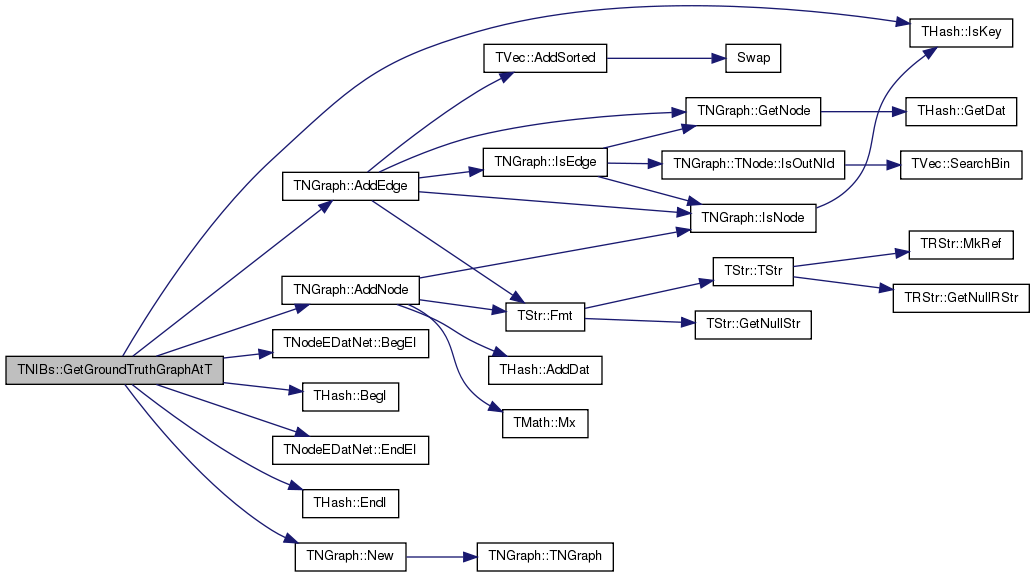
| void TNIBs::GetGroundTruthNetworkAtT | ( | const double & | Step, |
| PStrFltNEDNet & | NetworkAtT | ||
| ) |
Definition at line 295 of file cascdynetinf.cpp.
References TNodeEDatNet< TNodeData, TEdgeData >::BegEI(), THash< TKey, TDat, THashFunc >::BegI(), TNodeEDatNet< TNodeData, TEdgeData >::EndEI(), THash< TKey, TDat, THashFunc >::EndI(), THash< TKey, TDat, THashFunc >::IsKey(), MinAlpha, Network, TNodeEDatNet< TNodeData, TEdgeData >::New(), and NodeNmH.
{
NetworkAtT = TStrFltNEDNet::New();
for (THash<TInt, TNodeInfo>::TIter NI = NodeNmH.BegI(); NI < NodeNmH.EndI(); NI++) { NetworkAtT->AddNode(NI.GetKey(), NI.GetDat().Name); }
for (TStrFltFltHNEDNet::TEdgeI EI = Network.BegEI(); EI < Network.EndEI(); EI++) {
if (!NodeNmH.IsKey(EI.GetSrcNId()) || !NodeNmH.IsKey(EI.GetDstNId())) { continue; }
double Alpha = 0.0;
if (EI().IsKey(Step)) { Alpha = EI().GetDat(Step); }
if (Alpha > MinAlpha) {
NetworkAtT->AddEdge(EI.GetSrcNId(), EI.GetDstNId(), Alpha);
}
}
}
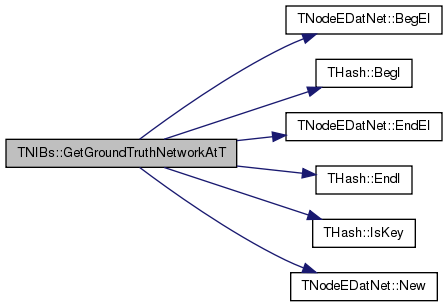
| void TNIBs::GetInferredGraphAtT | ( | const double & | Step, |
| PNGraph & | GraphAtT | ||
| ) |
Definition at line 311 of file cascdynetinf.cpp.
References TNGraph::AddEdge(), TNGraph::AddNode(), TNodeEDatNet< TNodeData, TEdgeData >::BegEI(), THash< TKey, TDat, THashFunc >::BegI(), TNodeEDatNet< TNodeData, TEdgeData >::EndEI(), THash< TKey, TDat, THashFunc >::EndI(), InferredNetwork, THash< TKey, TDat, THashFunc >::IsKey(), MinAlpha, TNGraph::New(), and NodeNmH.
{
GraphAtT = TNGraph::New();
for (THash<TInt, TNodeInfo>::TIter NI = NodeNmH.BegI(); NI < NodeNmH.EndI(); NI++) { GraphAtT->AddNode(NI.GetKey()); }
for (TStrFltFltHNEDNet::TEdgeI EI = InferredNetwork.BegEI(); EI < InferredNetwork.EndEI(); EI++) {
if (!NodeNmH.IsKey(EI.GetSrcNId()) || !NodeNmH.IsKey(EI.GetDstNId())) { continue; }
double inferredAlpha = 0.0;
if (EI().IsKey(Step)) { inferredAlpha = EI().GetDat(Step); }
if (inferredAlpha > MinAlpha) {
GraphAtT->AddEdge(EI.GetSrcNId(), EI.GetDstNId());
}
}
}
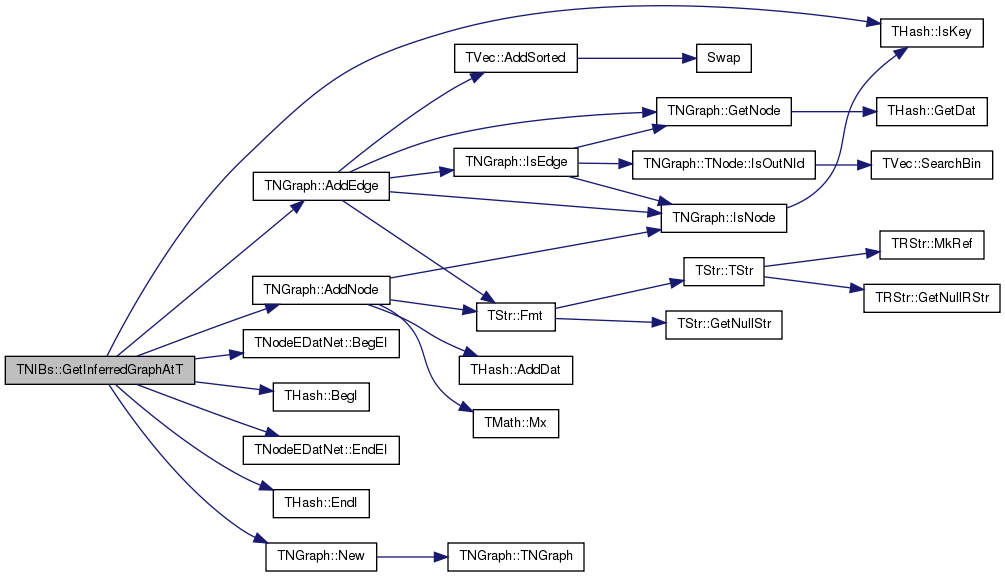
| void TNIBs::GetInferredNetworkAtT | ( | const double & | Step, |
| PStrFltNEDNet & | NetworkAtT | ||
| ) |
Definition at line 328 of file cascdynetinf.cpp.
References TNodeEDatNet< TNodeData, TEdgeData >::BegEI(), THash< TKey, TDat, THashFunc >::BegI(), TNodeEDatNet< TNodeData, TEdgeData >::EndEI(), THash< TKey, TDat, THashFunc >::EndI(), InferredNetwork, THash< TKey, TDat, THashFunc >::IsKey(), MinAlpha, TNodeEDatNet< TNodeData, TEdgeData >::New(), and NodeNmH.
{
NetworkAtT = TStrFltNEDNet::New();
for (THash<TInt, TNodeInfo>::TIter NI = NodeNmH.BegI(); NI < NodeNmH.EndI(); NI++) {
NetworkAtT->AddNode(NI.GetKey(), NI.GetDat().Name);
}
for (TStrFltFltHNEDNet::TEdgeI EI = InferredNetwork.BegEI(); EI < InferredNetwork.EndEI(); EI++) {
if (!NodeNmH.IsKey(EI.GetSrcNId()) || !NodeNmH.IsKey(EI.GetDstNId())) { continue; }
double inferredAlpha = 0.0;
if (EI().IsKey(Step)) { inferredAlpha = EI().GetDat(Step); }
if (inferredAlpha > MinAlpha) {
NetworkAtT->AddEdge(EI.GetSrcNId(), EI.GetDstNId(), inferredAlpha);
}
}
}
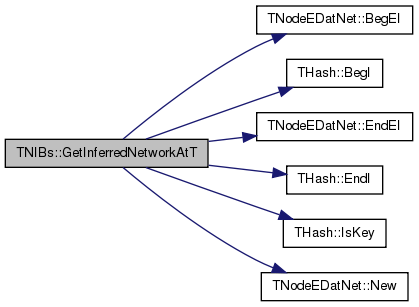
| TNodeInfo TNIBs::GetNodeInfo | ( | const int & | NId | ) | const [inline] |
Definition at line 217 of file cascdynetinf.h.
References THash< TKey, TDat, THashFunc >::GetDat(), and NodeNmH.
Referenced by AddCasc().


| TStr TNIBs::GetNodeNm | ( | const int & | NId | ) | const [inline] |
Definition at line 216 of file cascdynetinf.h.
References THash< TKey, TDat, THashFunc >::GetDat(), TNodeInfo::Name, and NodeNmH.

| int TNIBs::GetNodes | ( | ) | [inline] |
Definition at line 214 of file cascdynetinf.h.
References TNodeEDatNet< TNodeData, TEdgeData >::GetNodes(), and InferredNetwork.
{ return InferredNetwork.GetNodes(); }

| void TNIBs::Init | ( | const TFltV & | Steps | ) |
Definition at line 347 of file cascdynetinf.cpp.
References Accuracy, TVec< TVal, TSizeTy >::Add(), TNodeEDatNet< TNodeData, TEdgeData >::AddNode(), THash< TKey, TDat, THashFunc >::BegI(), THash< TKey, TDat, THashFunc >::Clr(), TVec< TVal, TSizeTy >::Clr(), TNodeEDatNet< TNodeData, TEdgeData >::Clr(), THash< TKey, TDat, THashFunc >::EndI(), InferredNetwork, TVec< TVal, TSizeTy >::Len(), MAE, MSE, NodeNmH, PrecisionRecall, and TotalCascadesAlpha.
{
// inferred network
InferredNetwork.Clr();
// copy nodes from NodeNmH (it will be filled by loading cascades or loading groundtruth)
for (THash<TInt, TNodeInfo>::TIter NI = NodeNmH.BegI(); NI < NodeNmH.EndI(); NI++) {
InferredNetwork.AddNode(NI.GetKey(), NI.GetDat().Name);
}
// performance measures
PrecisionRecall.Clr();
Accuracy.Clr();
MAE.Clr();
TotalCascadesAlpha.Clr();
for (int i=0; i<Steps.Len()-1; i++) {
MAE.Add(TFltPr(Steps[i], 0.0));
MSE.Add(TFltPr(Steps[i], 0.0));
Accuracy.Add(TFltPr(Steps[i], 0.0));
PrecisionRecall.Add(TFltPr(0.0,0.0));
}
}

| bool TNIBs::IsCascade | ( | int | c | ) | [inline] |
Definition at line 208 of file cascdynetinf.h.
References CascH, and THash< TKey, TDat, THashFunc >::IsKey().

| bool TNIBs::IsDomainNm | ( | const TStr & | Domain | ) | const [inline] |
Definition at line 223 of file cascdynetinf.h.
References DomainsIdH, and THash< TKey, TDat, THashFunc >::IsKey().
{ return DomainsIdH.IsKey(Domain); }

| bool TNIBs::IsNodeNm | ( | const int & | NId | ) | const [inline] |
Definition at line 218 of file cascdynetinf.h.
References THash< TKey, TDat, THashFunc >::IsKey(), and NodeNmH.
Referenced by LoadGroundTruthNodesTxt(), LoadGroundTruthTxt(), LoadInferredNodesTxt(), and LoadInferredTxt().

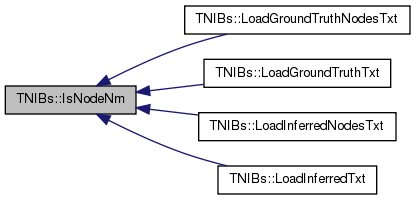
| void TNIBs::LabelBurstAutomaton | ( | const int & | SrcId, |
| const int & | DstId, | ||
| TIntV & | state_labels, | ||
| TFltV & | state_times, | ||
| const bool & | inferred = false, |
||
| const int & | k = 5, |
||
| const double & | s = 2.0, |
||
| const double & | gamma = 1.0, |
||
| const TSecTm & | MinTime = TSecTm(), |
||
| const TSecTm & | MaxTime = TSecTm() |
||
| ) |
Definition at line 886 of file cascdynetinf.cpp.
References TVec< TVal, TSizeTy >::Add(), find_C(), find_min_state(), TSecTm::GetAbsSecs(), TNodeEDatNet< TNodeData, TEdgeData >::GetEDat(), THash< TKey, TDat, THashFunc >::GetKey(), InferredNetwork, TVec< TVal, TSizeTy >::Last(), THash< TKey, TDat, THashFunc >::Len(), TVec< TVal, TSizeTy >::Len(), MinAlpha, Network, and TVec< TVal, TSizeTy >::Sort().
{
TVec<TSecTm> arrival_times;
TFltFltH &LinksEdge = (inferred? InferredNetwork.GetEDat(SrcId, DstId) : Network.GetEDat(SrcId, DstId));
for (int i=0; i<LinksEdge.Len(); i++) {
if (LinksEdge[i]>MinAlpha) {
TSecTm tsecs;
tsecs = (uint)LinksEdge.GetKey(i); // link rates is in seconds
if (tsecs > MaxTime || tsecs < MinTime) { continue; }
arrival_times.Add(tsecs);
}
}
if ( arrival_times.Len() < 2 ) return;
TFltV x;
x.Add( 0 );
arrival_times.Sort(true);
double T = ((double)arrival_times.Last().GetAbsSecs()) - ((double)arrival_times[0].GetAbsSecs());
for (int i = 1; i < arrival_times.Len(); i++){
x.Add( ((double)arrival_times[i].GetAbsSecs()) - ((double)arrival_times[i-1].GetAbsSecs()) );
}
TFltVV Cost_matrix;
//printf("arrivals = %d\n", x.Len() );
find_C( 0, x, Cost_matrix, k, s, gamma, T);
find_min_state( Cost_matrix, state_labels, k, s, gamma, T );
for (int i=0; i<state_labels.Len(); i++) { state_times.Add((double)arrival_times[i].GetAbsSecs()); }
}
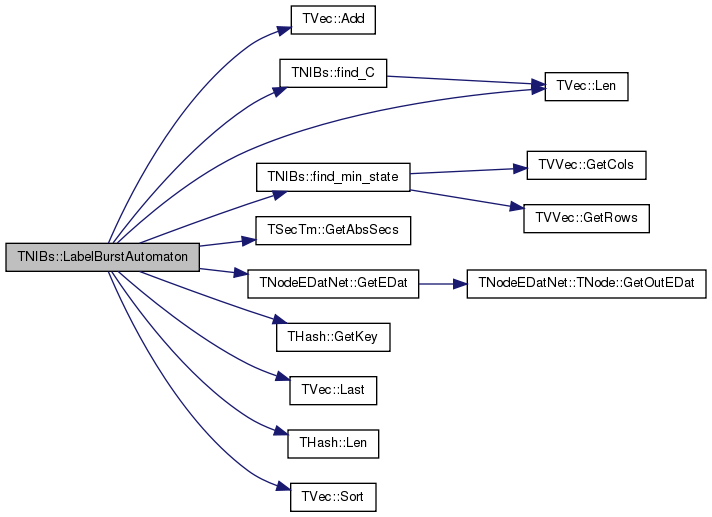
| void TNIBs::LoadCascadesTxt | ( | TSIn & | SIn | ) |
Definition at line 4 of file cascdynetinf.cpp.
References AddCasc(), AddNodeNm(), TSIn::Eof(), TSIn::GetNextLn(), Model, and TStr::SplitOnAllCh().
{
TStr Line;
while (!SIn.Eof()) {
SIn.GetNextLn(Line);
if (Line=="") { break; }
TStrV NIdV; Line.SplitOnAllCh(',', NIdV);
AddNodeNm(NIdV[0].GetInt(), TNodeInfo(NIdV[1], 0));
}
printf("All nodes read!\n");
while (!SIn.Eof()) { SIn.GetNextLn(Line); AddCasc(Line, Model); }
printf("All cascades read!\n");
}
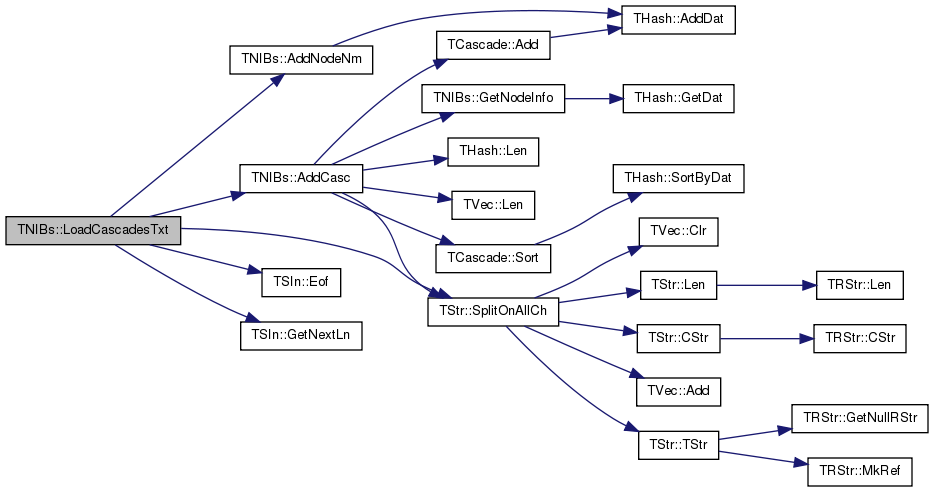
| void TNIBs::LoadGroundTruthNodesTxt | ( | TSIn & | SIn | ) |
Definition at line 63 of file cascdynetinf.cpp.
References THash< TKey, TDat, THashFunc >::AddDat(), TNodeEDatNet< TNodeData, TEdgeData >::AddNode(), AddNodeNm(), TNodeEDatNet< TNodeData, TEdgeData >::Clr(), DomainsIdH, TSIn::Eof(), TSIn::GetNextLn(), TNodeEDatNet< TNodeData, TEdgeData >::GetNodes(), IsNodeNm(), Network, and TStr::SplitOnAllCh().
{
TStr Line;
Network.Clr(); // clear network (if any)
// add nodes
while (!SIn.Eof()) {
SIn.GetNextLn(Line);
if (Line=="") { break; }
TStrV NIdV; Line.SplitOnAllCh(',', NIdV);
Network.AddNode(NIdV[0].GetInt(), NIdV[1]);
if (!IsNodeNm(NIdV[0].GetInt())) {
AddNodeNm(NIdV[0].GetInt(), TNodeInfo(NIdV[1], 0));
DomainsIdH.AddDat(NIdV[1]) = NIdV[0].GetInt();
}
}
printf("groundtruth nodes:%d\n", Network.GetNodes());
}
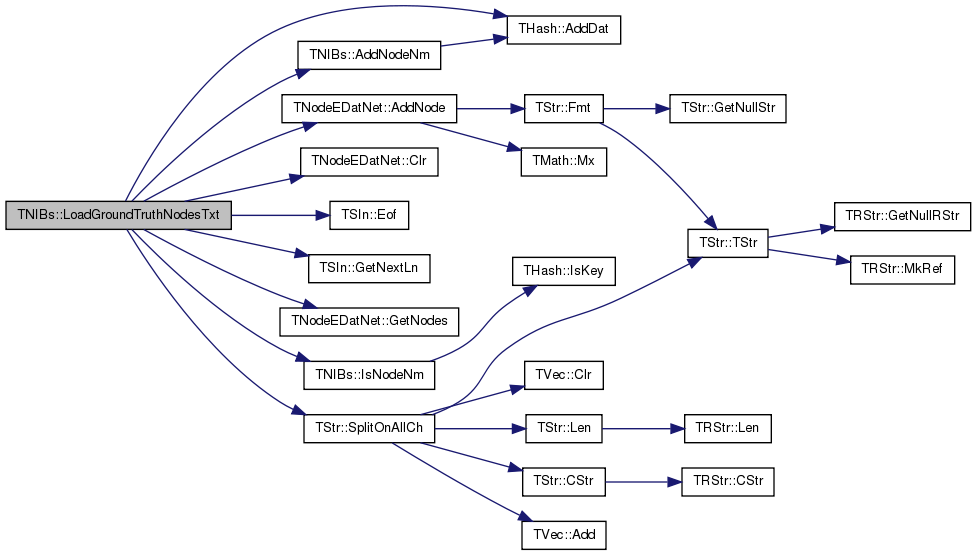
| void TNIBs::LoadGroundTruthTxt | ( | TSIn & | SIn | ) |
Definition at line 18 of file cascdynetinf.cpp.
References THash< TKey, TDat, THashFunc >::AddDat(), TNodeEDatNet< TNodeData, TEdgeData >::AddEdge(), TNodeEDatNet< TNodeData, TEdgeData >::AddNode(), AddNodeNm(), TNodeEDatNet< TNodeData, TEdgeData >::Clr(), DomainsIdH, TSIn::Eof(), TNodeEDatNet< TNodeData, TEdgeData >::GetEDat(), TNodeEDatNet< TNodeData, TEdgeData >::GetEdges(), THash< TKey, TDat, THashFunc >::GetKey(), TSIn::GetNextLn(), TNodeEDatNet< TNodeData, TEdgeData >::GetNodes(), IsNodeNm(), THash< TKey, TDat, THashFunc >::Len(), TVec< TVal, TSizeTy >::Len(), Network, and TStr::SplitOnAllCh().
{
bool verbose = false;
TStr Line;
Network.Clr(); // clear network (if any)
// add nodes
while (!SIn.Eof()) {
SIn.GetNextLn(Line);
if (Line=="") { break; }
TStrV NIdV; Line.SplitOnAllCh(',', NIdV);
Network.AddNode(NIdV[0].GetInt(), NIdV[1]);
if (!IsNodeNm(NIdV[0].GetInt())) {
AddNodeNm(NIdV[0].GetInt(), TNodeInfo(NIdV[1], 0));
DomainsIdH.AddDat(NIdV[1]) = NIdV[0].GetInt();
}
}
// add edges
while (!SIn.Eof()) {
SIn.GetNextLn(Line);
TStrV FieldsV; Line.SplitOnAllCh(',', FieldsV);
TFltFltH Alphas;
if (FieldsV.Len() == 3) {
Alphas.AddDat(0.0) = FieldsV[2].GetFlt();
} else {
for (int i=2; i<FieldsV.Len()-1; i+=2) {
Alphas.AddDat(FieldsV[i].GetFlt()) = FieldsV[i+1].GetFlt();
}
}
Network.AddEdge(FieldsV[0].GetInt(), FieldsV[1].GetInt(), Alphas);
if (verbose) {
printf("Edge %d -> %d: ", FieldsV[0].GetInt(), FieldsV[1].GetInt());
TFltFltH &AlphasE = Network.GetEDat(FieldsV[0].GetInt(), FieldsV[1].GetInt());
for (int i=0; i<AlphasE.Len(); i+=2) { printf("(%f, %f)", AlphasE.GetKey(i).Val, AlphasE[i].Val); }
printf("\n");
}
}
printf("groundtruth nodes:%d edges:%d\n", Network.GetNodes(), Network.GetEdges());
}
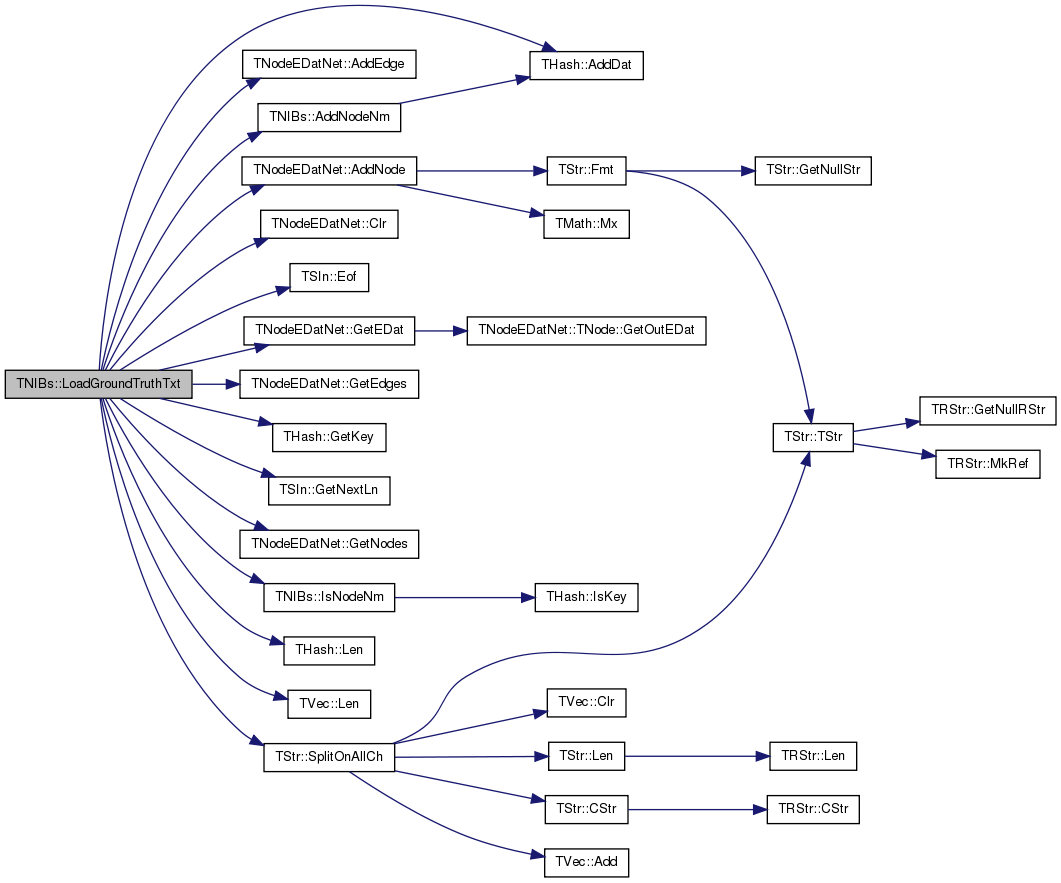
| void TNIBs::LoadInferredNodesTxt | ( | TSIn & | SIn | ) |
Definition at line 128 of file cascdynetinf.cpp.
References THash< TKey, TDat, THashFunc >::AddDat(), TNodeEDatNet< TNodeData, TEdgeData >::AddNode(), AddNodeNm(), TNodeEDatNet< TNodeData, TEdgeData >::Clr(), DomainsIdH, TSIn::Eof(), THash< TKey, TDat, THashFunc >::GetDat(), TSIn::GetNextLn(), TNodeEDatNet< TNodeData, TEdgeData >::GetNodes(), IAssert, InferredNetwork, THash< TKey, TDat, THashFunc >::IsKey(), IsNodeNm(), and TStr::SplitOnAllCh().
{
TStr Line;
InferredNetwork.Clr(); // clear network (if any)
// add nodes
while (!SIn.Eof()) {
SIn.GetNextLn(Line);
if (Line=="") { break; }
TStrV NIdV; Line.SplitOnAllCh(',', NIdV);
if (DomainsIdH.IsKey(NIdV[1])) { IAssert(NIdV[0].GetInt()==DomainsIdH.GetDat(NIdV[1])); }
InferredNetwork.AddNode(NIdV[0].GetInt(), NIdV[1]);
if (!IsNodeNm(NIdV[0].GetInt())) { AddNodeNm(NIdV[0].GetInt(), TNodeInfo(NIdV[1], 0)); }
if (!DomainsIdH.IsKey(NIdV[1])) { DomainsIdH.AddDat(NIdV[1]) = NIdV[0].GetInt(); }
}
printf("Nodes:%d\n", InferredNetwork.GetNodes());
}
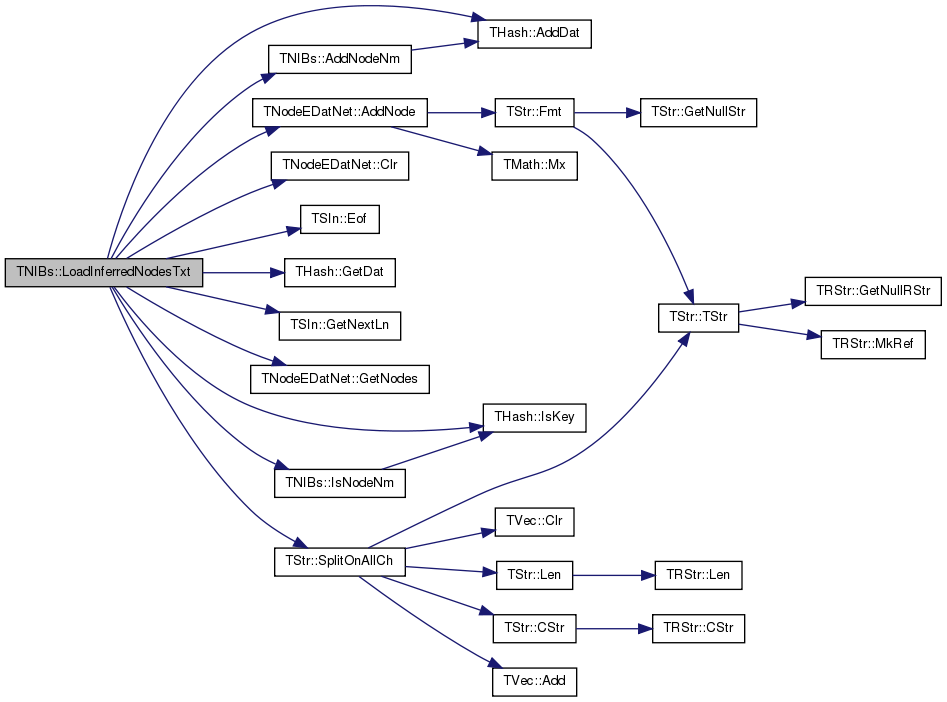
| void TNIBs::LoadInferredTxt | ( | TSIn & | SIn | ) |
Definition at line 83 of file cascdynetinf.cpp.
References THash< TKey, TDat, THashFunc >::AddDat(), TNodeEDatNet< TNodeData, TEdgeData >::AddEdge(), TNodeEDatNet< TNodeData, TEdgeData >::AddNode(), AddNodeNm(), TNodeEDatNet< TNodeData, TEdgeData >::Clr(), DomainsIdH, TSIn::Eof(), THash< TKey, TDat, THashFunc >::GetDat(), TNodeEDatNet< TNodeData, TEdgeData >::GetEDat(), TNodeEDatNet< TNodeData, TEdgeData >::GetEdges(), THash< TKey, TDat, THashFunc >::GetKey(), TSIn::GetNextLn(), TNodeEDatNet< TNodeData, TEdgeData >::GetNodes(), IAssert, InferredNetwork, THash< TKey, TDat, THashFunc >::IsKey(), IsNodeNm(), THash< TKey, TDat, THashFunc >::Len(), TVec< TVal, TSizeTy >::Len(), and TStr::SplitOnAllCh().
{
bool verbose = false;
TStr Line;
InferredNetwork.Clr(); // clear network (if any)
// add nodes
while (!SIn.Eof()) {
SIn.GetNextLn(Line);
if (Line=="") { break; }
TStrV NIdV; Line.SplitOnAllCh(',', NIdV);
if (DomainsIdH.IsKey(NIdV[1])) { IAssert(NIdV[0].GetInt()==DomainsIdH.GetDat(NIdV[1])); }
InferredNetwork.AddNode(NIdV[0].GetInt(), NIdV[1]);
if (!IsNodeNm(NIdV[0].GetInt())) { AddNodeNm(NIdV[0].GetInt(), TNodeInfo(NIdV[1], 0)); }
if (!DomainsIdH.IsKey(NIdV[1])) { DomainsIdH.AddDat(NIdV[1]) = NIdV[0].GetInt(); }
if (verbose) { printf("Node:%s\n", NIdV[1].CStr()); }
}
// add edges
while (!SIn.Eof()) {
SIn.GetNextLn(Line);
TStrV FieldsV; Line.SplitOnAllCh(',', FieldsV);
TFltFltH Alphas;
if (FieldsV.Len() == 3) {
Alphas.AddDat(0.0) = FieldsV[2].GetFlt();
} else {
for (int i=2; i<FieldsV.Len()-1; i+=2) {
Alphas.AddDat(FieldsV[i].GetFlt()) = FieldsV[i+1].GetFlt();
}
}
InferredNetwork.AddEdge(FieldsV[0].GetInt(), FieldsV[1].GetInt(), Alphas);
if (verbose) {
printf("Edge %d -> %d: ", FieldsV[0].GetInt(), FieldsV[1].GetInt());
TFltFltH &AlphasE = InferredNetwork.GetEDat(FieldsV[0].GetInt(), FieldsV[1].GetInt());
for (int i=0; i<AlphasE.Len(); i+=2) { printf("(%f, %f)", AlphasE.GetKey(i).Val, AlphasE[i].Val); }
printf("\n");
}
}
printf("inferred nodes:%d edges:%d\n", InferredNetwork.GetNodes(), InferredNetwork.GetEdges());
}
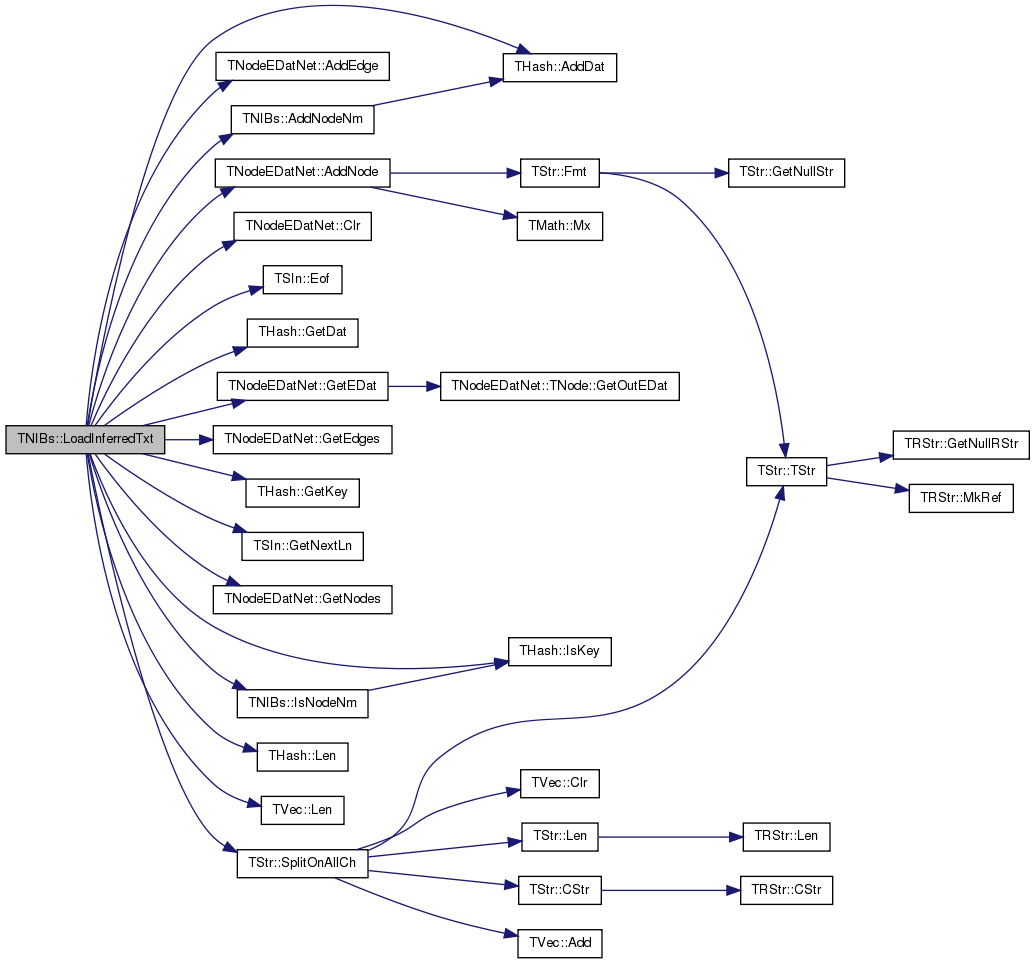
| void TNIBs::Reset | ( | ) |
Definition at line 370 of file cascdynetinf.cpp.
References AveDiffAlphas, THash< TKey, TDat, THashFunc >::Clr(), DiffAlphas, THash< TKey, TDat, THashFunc >::Len(), SampledCascadesH, and TotalCascadesAlpha.
Referenced by BSG(), FG(), and SG().
{
// reset vectors
for (int i=0; i<DiffAlphas.Len(); i++) {
DiffAlphas[i].Clr();
}
DiffAlphas.Clr();
AveDiffAlphas.Clr();
SampledCascadesH.Clr();
TotalCascadesAlpha.Clr();
}

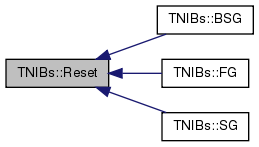
| void TNIBs::Save | ( | TSOut & | SOut | ) | const [inline] |
Definition at line 175 of file cascdynetinf.h.
References CascH, CascPerEdge, InferredNetwork, NodeNmH, THash< TKey, TDat, THashFunc >::Save(), and TNodeEDatNet< TNodeData, TEdgeData >::Save().
{ CascH.Save(SOut); NodeNmH.Save(SOut); CascPerEdge.Save(SOut); InferredNetwork.Save(SOut); }

| void TNIBs::SaveCascades | ( | const TStr & | OutFNm | ) |
Definition at line 1168 of file cascdynetinf.cpp.
References THash< TKey, TDat, THashFunc >::BegI(), CascH, THash< TKey, TDat, THashFunc >::EndI(), TStr::Fmt(), THash< TKey, TDat, THashFunc >::IsKey(), TCascade::NIdHitH, NodeNmH, and TSOut::PutStr().
{
TFOut FOut(OutFNm);
// write nodes to file
for (THash<TInt, TNodeInfo>::TIter NI = NodeNmH.BegI(); NI < NodeNmH.EndI(); NI++) {
FOut.PutStr(TStr::Fmt("%d,%s\r\n", NI.GetKey().Val, NI.GetDat().Name.CStr()));
}
FOut.PutStr("\r\n");
// write cascades to file
for (THash<TInt, TCascade>::TIter CI = CascH.BegI(); CI < CascH.EndI(); CI++) {
TCascade &C = CI.GetDat();
int j = 0;
for (THash<TInt, THitInfo>::TIter NI = C.NIdHitH.BegI(); NI < C.NIdHitH.EndI(); NI++) {
if (!NodeNmH.IsKey(NI.GetDat().NId)) { continue; }
if (j > 0) { FOut.PutStr(TStr::Fmt(",%d,%f", NI.GetDat().NId.Val, NI.GetDat().Tm.Val)); }
else { FOut.PutStr(TStr::Fmt("%d;%d,%f", CI.GetKey().Val, NI.GetDat().NId.Val, NI.GetDat().Tm.Val)); }
j++;
}
if (j >= 1)
FOut.PutStr(TStr::Fmt("\r\n"));
}
}
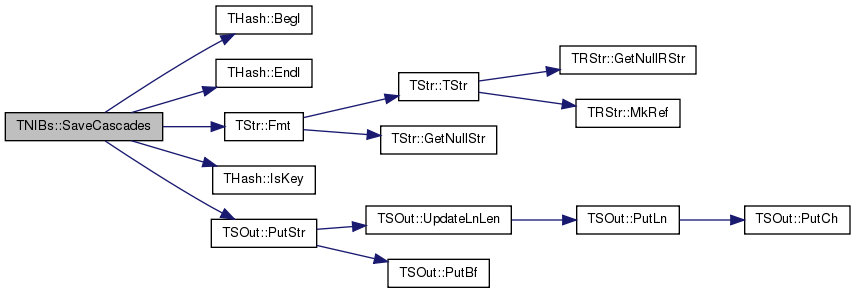
| void TNIBs::SaveGroundTruth | ( | const TStr & | OutFNm | ) |
Definition at line 1105 of file cascdynetinf.cpp.
References TNodeEDatNet< TNodeData, TEdgeData >::BegEI(), THash< TKey, TDat, THashFunc >::BegI(), TNodeEDatNet< TNodeData, TEdgeData >::EndEI(), THash< TKey, TDat, THashFunc >::EndI(), TStr::Fmt(), THash< TKey, TDat, THashFunc >::IsKey(), Network, NodeNmH, and TSOut::PutStr().
{
TFOut FOut(OutFNm);
// write nodes to file
for (THash<TInt, TNodeInfo>::TIter NI = NodeNmH.BegI(); NI < NodeNmH.EndI(); NI++) {
FOut.PutStr(TStr::Fmt("%d,%s\r\n", NI.GetKey().Val, NI.GetDat().Name.CStr()));
}
FOut.PutStr("\r\n");
// write edges to file (not allowing self loops in the network)
for (TStrFltFltHNEDNet::TEdgeI EI = Network.BegEI(); EI < Network.EndEI(); EI++) {
if (!NodeNmH.IsKey(EI.GetSrcNId()) || !NodeNmH.IsKey(EI.GetDstNId())) { continue; }
// not allowing self loops in the Kronecker network
if (EI.GetSrcNId() != EI.GetDstNId()) {
if (EI().Len() > 0) {
FOut.PutStr(TStr::Fmt("%d,%d,", EI.GetSrcNId(), EI.GetDstNId()));
for (int i=0; i<EI().Len()-1; i++) { FOut.PutStr(TStr::Fmt("%f,%f,", EI().GetKey(i).Val, EI()[i].Val)); }
FOut.PutStr(TStr::Fmt("%f,%f", EI().GetKey(EI().Len()-1).Val, EI()[EI().Len()-1].Val));
FOut.PutStr("\r\n");
}
else
FOut.PutStr(TStr::Fmt("%d,%d,1\r\n", EI.GetSrcNId(), EI.GetDstNId()));
}
}
}
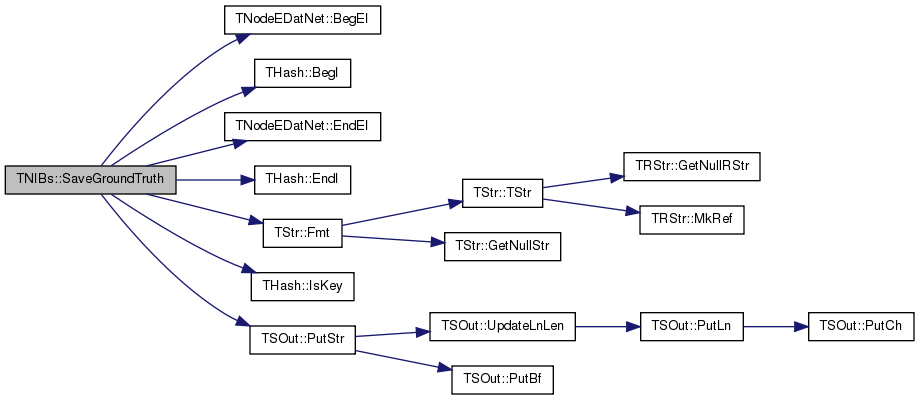
| void TNIBs::SaveGroundTruthPajek | ( | const TStr & | OutFNm, |
| const double & | Step | ||
| ) |
Definition at line 1133 of file cascdynetinf.cpp.
References TNodeEDatNet< TNodeData, TEdgeData >::BegEI(), THash< TKey, TDat, THashFunc >::BegI(), TNodeEDatNet< TNodeData, TEdgeData >::EndEI(), THash< TKey, TDat, THashFunc >::EndI(), TStr::Fmt(), THash< TKey, TDat, THashFunc >::IsKey(), THash< TKey, TDat, THashFunc >::Len(), MaxAlpha, MinAlpha, Network, NodeNmH, TSOut::PutStr(), and TFlt::Val.
{
TFOut FOut(OutFNm);
FOut.PutStr(TStr::Fmt("*Vertices %d\r\n", NodeNmH.Len()));
for (THash<TInt, TNodeInfo>::TIter NI = NodeNmH.BegI(); NI < NodeNmH.EndI(); NI++) {
FOut.PutStr(TStr::Fmt("%d \"%s\" ic Blue\r\n", NI.GetKey().Val+1, NI.GetDat().Name.CStr()));
}
FOut.PutStr("*Arcs\r\n");
for (TStrFltFltHNEDNet::TEdgeI EI = Network.BegEI(); EI < Network.EndEI(); EI++) {
if (!NodeNmH.IsKey(EI.GetSrcNId()) || !NodeNmH.IsKey(EI.GetDstNId())) { continue; }
double trueAlpha = 0.0;
if (EI().IsKey(Step)) { trueAlpha = EI().GetDat(Step); }
else { for (int j=0; j<EI().Len() && EI().GetKey(j)<=Step; j++) { trueAlpha = EI()[j]; } }
if (trueAlpha > MinAlpha) {
FOut.PutStr(TStr::Fmt("%d %d %f\r\n", EI.GetSrcNId()+1, EI.GetDstNId()+1, (trueAlpha > MaxAlpha? MaxAlpha.Val : trueAlpha)));
}
}
}
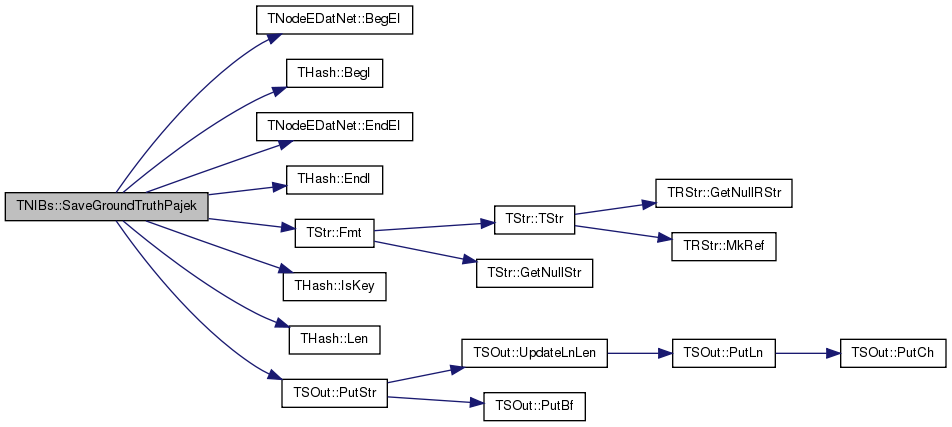
| void TNIBs::SaveInferred | ( | const TStr & | OutFNm, |
| const TIntV & | NIdV = TIntV() |
||
| ) |
Definition at line 1003 of file cascdynetinf.cpp.
References TNodeEDatNet< TNodeData, TEdgeData >::BegEI(), THash< TKey, TDat, THashFunc >::BegI(), TNodeEDatNet< TNodeData, TEdgeData >::EndEI(), THash< TKey, TDat, THashFunc >::EndI(), TStr::Fmt(), InferredNetwork, TVec< TVal, TSizeTy >::IsIn(), THash< TKey, TDat, THashFunc >::IsKey(), TVec< TVal, TSizeTy >::Len(), MaxAlpha, MinAlpha, NodeNmH, TSOut::PutStr(), and TFlt::Val.
{
TFOut FOut(OutFNm);
// write nodes to file
for (THash<TInt, TNodeInfo>::TIter NI = NodeNmH.BegI(); NI < NodeNmH.EndI(); NI++) {
if (NIdV.Len() > 0 && !NIdV.IsIn(NI.GetKey())) { continue; }
FOut.PutStr(TStr::Fmt("%d,%s\r\n", NI.GetKey().Val, NI.GetDat().Name.CStr()));
}
FOut.PutStr("\r\n");
// write edges to file (not allowing self loops in the network)
for (TStrFltFltHNEDNet::TEdgeI EI = InferredNetwork.BegEI(); EI < InferredNetwork.EndEI(); EI++) {
if (NIdV.Len() > 0 && (!NIdV.IsIn(EI.GetSrcNId()) || !NIdV.IsIn(EI.GetDstNId()))) { continue; }
if (!NodeNmH.IsKey(EI.GetSrcNId()) || !NodeNmH.IsKey(EI.GetDstNId())) { continue; }
// not allowing self loops in the Kronecker network
if (EI.GetSrcNId() != EI.GetDstNId()) {
if (EI().Len() > 0) {
TStr Line; bool IsEdge = false;
for (int i=0; i<EI().Len(); i++) {
if (EI()[i]>MinAlpha) {
Line += TStr::Fmt(",%f,%f", EI().GetKey(i).Val, (EI()[i] > MaxAlpha? MaxAlpha.Val : EI()[i].Val) );
IsEdge = true;
} else { // we write 0 explicitly
Line += TStr::Fmt(",%f,0.0", EI().GetKey(i).Val);
}
}
// if none of the alphas is bigger than 0, no edge is written
if (IsEdge) {
FOut.PutStr(TStr::Fmt("%d,%d", EI.GetSrcNId(), EI.GetDstNId()));
FOut.PutStr(Line);
FOut.PutStr("\r\n");
}
}
else
FOut.PutStr(TStr::Fmt("%d,%d,1\r\n", EI.GetSrcNId(), EI.GetDstNId()));
}
}
}
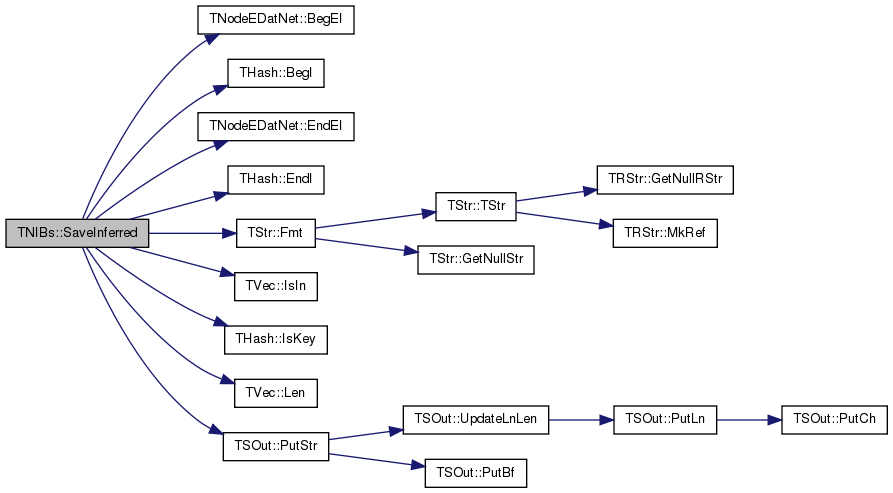
| void TNIBs::SaveInferred | ( | const TStr & | OutFNm, |
| const double & | Step, | ||
| const TIntV & | NIdV = TIntV() |
||
| ) |
Definition at line 1045 of file cascdynetinf.cpp.
References TNodeEDatNet< TNodeData, TEdgeData >::BegEI(), THash< TKey, TDat, THashFunc >::BegI(), TNodeEDatNet< TNodeData, TEdgeData >::EndEI(), THash< TKey, TDat, THashFunc >::EndI(), TStr::Fmt(), InferredNetwork, TVec< TVal, TSizeTy >::IsIn(), THash< TKey, TDat, THashFunc >::IsKey(), TVec< TVal, TSizeTy >::Len(), MaxAlpha, MinAlpha, NodeNmH, TSOut::PutStr(), and TFlt::Val.
{
TFOut FOut(OutFNm);
// write nodes to file
for (THash<TInt, TNodeInfo>::TIter NI = NodeNmH.BegI(); NI < NodeNmH.EndI(); NI++) {
if (NIdV.Len() > 0 && !NIdV.IsIn(NI.GetKey())) { continue; }
FOut.PutStr(TStr::Fmt("%d,%s\r\n", NI.GetKey().Val, NI.GetDat().Name.CStr()));
}
FOut.PutStr("\r\n");
// write edges to file (not allowing self loops in the network)
for (TStrFltFltHNEDNet::TEdgeI EI = InferredNetwork.BegEI(); EI < InferredNetwork.EndEI(); EI++) {
if (NIdV.Len() > 0 && (!NIdV.IsIn(EI.GetSrcNId()) || !NIdV.IsIn(EI.GetDstNId()))) { continue; }
if (!NodeNmH.IsKey(EI.GetSrcNId()) || !NodeNmH.IsKey(EI.GetDstNId())) { continue; }
// not allowing self loops in the Kronecker network
if (EI.GetSrcNId() != EI.GetDstNId()) {
double inferredAlpha = 0.0;
if (EI().IsKey(Step)) { inferredAlpha = EI().GetDat(Step); }
if (inferredAlpha > MinAlpha) {
FOut.PutStr(TStr::Fmt("%d,%d,%f\r\n", EI.GetSrcNId(), EI.GetDstNId(), (inferredAlpha > MaxAlpha? MaxAlpha.Val : inferredAlpha)));
}
}
}
}

| void TNIBs::SaveInferredEdges | ( | const TStr & | OutFNm | ) |
Definition at line 1073 of file cascdynetinf.cpp.
References TNodeEDatNet< TNodeData, TEdgeData >::BegEI(), TNodeEDatNet< TNodeData, TEdgeData >::EndEI(), TStr::Fmt(), InferredNetwork, THash< TKey, TDat, THashFunc >::IsKey(), MaxAlpha, MinAlpha, NodeNmH, TSOut::PutStr(), and TFlt::Val.
{
TFOut FOut(OutFNm);
// write edges to file (not allowing self loops in the network)
for (TStrFltFltHNEDNet::TEdgeI EI = InferredNetwork.BegEI(); EI < InferredNetwork.EndEI(); EI++) {
if (!NodeNmH.IsKey(EI.GetSrcNId()) || !NodeNmH.IsKey(EI.GetDstNId())) { continue; }
// not allowing self loops in the Kronecker network
if (EI.GetSrcNId() != EI.GetDstNId()) {
if (EI().Len() > 0) {
TStr Line; bool IsEdge = false;
for (int i=0; i<EI().Len(); i++) {
if (EI()[i]>MinAlpha) {
Line += TStr::Fmt(",%f,%f", EI().GetKey(i).Val, (EI()[i] > MaxAlpha? MaxAlpha.Val : EI()[i].Val) );
IsEdge = true;
} else { // we write 0 explicitly
Line += TStr::Fmt(",%f,0.0", EI().GetKey(i).Val);
}
}
// if none of the alphas is bigger than 0, no edge is written
if (IsEdge) {
FOut.PutStr(TStr::Fmt("%d,%d", EI.GetSrcNId(), EI.GetDstNId()));
FOut.PutStr(Line);
FOut.PutStr("\r\n");
}
}
else
FOut.PutStr(TStr::Fmt("%d,%d,1\r\n", EI.GetSrcNId(), EI.GetDstNId()));
}
}
}

| void TNIBs::SaveInferredPajek | ( | const TStr & | OutFNm, |
| const double & | Step, | ||
| const TIntV & | NIdV = TIntV() |
||
| ) |
Definition at line 981 of file cascdynetinf.cpp.
References TNodeEDatNet< TNodeData, TEdgeData >::BegEI(), THash< TKey, TDat, THashFunc >::BegI(), TNodeEDatNet< TNodeData, TEdgeData >::EndEI(), THash< TKey, TDat, THashFunc >::EndI(), TStr::Fmt(), InferredNetwork, TVec< TVal, TSizeTy >::IsIn(), THash< TKey, TDat, THashFunc >::IsKey(), THash< TKey, TDat, THashFunc >::Len(), TVec< TVal, TSizeTy >::Len(), MaxAlpha, MinAlpha, NodeNmH, TSOut::PutStr(), and TFlt::Val.
{
TFOut FOut(OutFNm);
FOut.PutStr(TStr::Fmt("*Vertices %d\r\n", NodeNmH.Len()));
for (THash<TInt, TNodeInfo>::TIter NI = NodeNmH.BegI(); NI < NodeNmH.EndI(); NI++) {
if (NIdV.Len() > 0 && !NIdV.IsIn(NI.GetKey())) { continue; }
FOut.PutStr(TStr::Fmt("%d \"%s\" ic Blue\r\n", NI.GetKey().Val+1, NI.GetDat().Name.CStr()));
}
FOut.PutStr("*Arcs\r\n");
for (TStrFltFltHNEDNet::TEdgeI EI = InferredNetwork.BegEI(); EI < InferredNetwork.EndEI(); EI++) {
if (NIdV.Len() > 0 && (!NIdV.IsIn(EI.GetSrcNId()) || !NIdV.IsIn(EI.GetDstNId()))) { continue; }
if (!NodeNmH.IsKey(EI.GetSrcNId()) || !NodeNmH.IsKey(EI.GetDstNId())) { continue; }
double inferredAlpha = 0.0;
if (EI().IsKey(Step)) { inferredAlpha = EI().GetDat(Step); }
if (inferredAlpha > MinAlpha) {
FOut.PutStr(TStr::Fmt("%d %d %f\r\n", EI.GetSrcNId()+1, EI.GetDstNId()+1, (inferredAlpha > MaxAlpha? MaxAlpha.Val : inferredAlpha)));
}
}
}
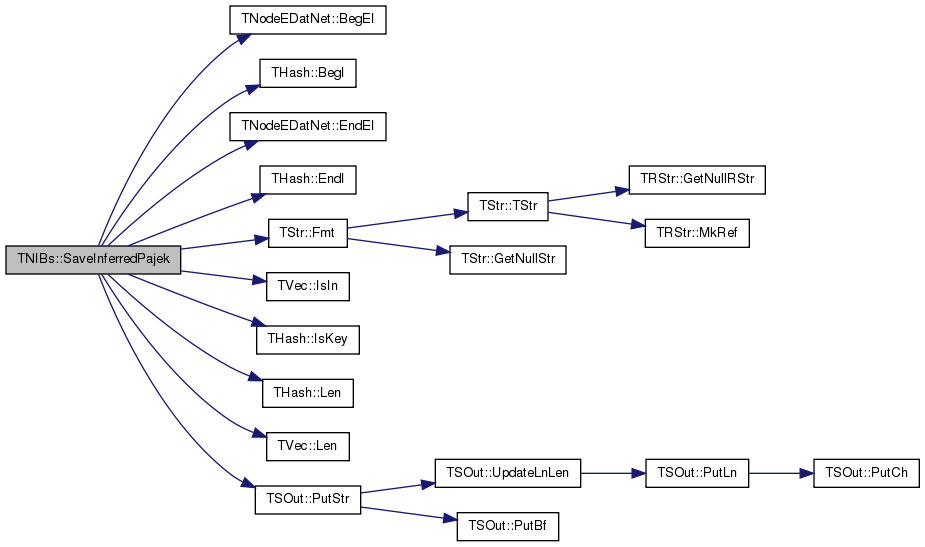
| void TNIBs::SaveSites | ( | const TStr & | OutFNm, |
| const TIntFltVH & | CascadesPerNode = TIntFltVH() |
||
| ) |
Definition at line 1153 of file cascdynetinf.cpp.
References THash< TKey, TDat, THashFunc >::BegI(), THash< TKey, TDat, THashFunc >::EndI(), TStr::Fmt(), THash< TKey, TDat, THashFunc >::GetDat(), THash< TKey, TDat, THashFunc >::IsKey(), NodeNmH, and TSOut::PutStr().
{
TFOut FOut(OutFNm);
// write nodes to file
for (THash<TInt, TNodeInfo>::TIter NI = NodeNmH.BegI(); NI < NodeNmH.EndI(); NI++) {
FOut.PutStr(TStr::Fmt("%d,%s", NI.GetKey().Val, NI.GetDat().Name.CStr()));
if (CascadesPerNode.IsKey(NI.GetKey().Val)) {
for (int i=0; i<CascadesPerNode.GetDat(NI.GetKey().Val).Len(); i++) {
FOut.PutStr(TStr::Fmt(",%f", CascadesPerNode.GetDat(NI.GetKey().Val)[i].Val));
}
}
FOut.PutStr("\r\n");
}
}
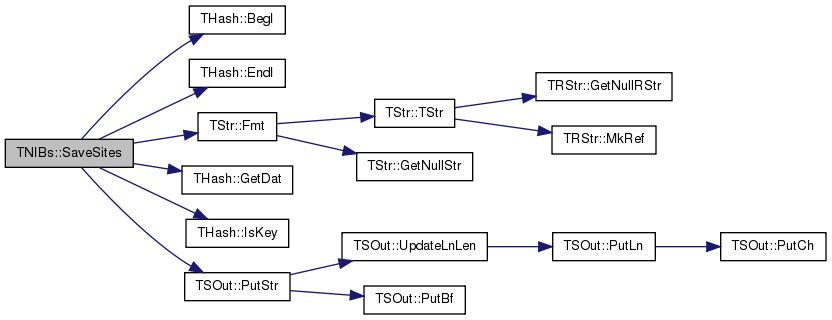
| void TNIBs::SetAging | ( | const double & | aging | ) | [inline] |
| void TNIBs::SetDelta | ( | const double & | delta | ) | [inline] |
| void TNIBs::SetGamma | ( | const double & | gamma | ) | [inline] |
| void TNIBs::SetInitAlpha | ( | const double & | ia | ) | [inline] |
| void TNIBs::SetK | ( | const double & | k | ) | [inline] |
| void TNIBs::SetMaxAlpha | ( | const double & | ma | ) | [inline] |
| void TNIBs::SetMinAlpha | ( | const double & | ma | ) | [inline] |
| void TNIBs::SetModel | ( | const TModel & | model | ) | [inline] |
| void TNIBs::SetMu | ( | const double & | mu | ) | [inline] |
| void TNIBs::SetRegularizer | ( | const TRegularizer & | reg | ) | [inline] |
| void TNIBs::SetTolerance | ( | const double & | tol | ) | [inline] |
| void TNIBs::SetTotalTime | ( | const float & | tt | ) | [inline] |
| void TNIBs::SetWindow | ( | const double & | window | ) | [inline] |
| void TNIBs::SG | ( | const int & | NId, |
| const int & | Iters, | ||
| const TFltV & | Steps, | ||
| const TSampling & | Sampling, | ||
| const TStr & | ParamSampling = TStr(""), |
||
| const bool & | PlotPerformance = false |
||
| ) |
Definition at line 381 of file cascdynetinf.cpp.
References THash< TKey, TDat, THashFunc >::AddDat(), Aging, AveDiffAlphas, TNodeEDatNet< TNodeData, TEdgeData >::BegEI(), CascH, THash< TKey, TDat, THashFunc >::Clr(), ComputePerformanceNId(), TNodeEDatNet< TNodeData, TEdgeData >::EndEI(), EXP_SAMPLING, Gamma, THash< TKey, TDat, THashFunc >::GetDat(), TNodeEDatNet< TNodeData, TEdgeData >::GetEDat(), THash< TKey, TDat, THashFunc >::GetKey(), TRnd::GetUniDevInt(), InferredNetwork, TNodeEDatNet< TNodeData, TEdgeData >::IsEdge(), THash< TKey, TDat, THashFunc >::IsKey(), THash< TKey, TDat, THashFunc >::Len(), TVec< TVal, TSizeTy >::Len(), MaxAlpha, Mu, OSG, RAY_SAMPLING, Regularizer, Reset(), TInt::Rnd, TFlt::Rnd, THash< TKey, TDat, THashFunc >::SortByDat(), TStr::SplitOnAllCh(), Tol, UNIF_SAMPLING, UpdateDiff(), TFlt::Val, WIN_EXP_SAMPLING, and WIN_SAMPLING.
{
bool verbose = false;
int currentCascade = -1;
TIntIntH SampledCascades;
TStrV ParamSamplingV; ParamSampling.SplitOnAllCh(';', ParamSamplingV);
Reset();
printf("Node %d\n", NId);
// traverse through all times
for (int t=1; t<Steps.Len(); t++) {
// find cascades whose two first infections are earlier than Steps[t]
TIntFltH CascadesIdx;
int num_infections = 0;
for (int i=0; i<CascH.Len(); i++) {
if (CascH[i].LenBeforeT(Steps[t]) > 1 &&
( (Sampling!=WIN_SAMPLING && Sampling!=WIN_EXP_SAMPLING) ||
(Sampling==WIN_SAMPLING && (Steps[t]-CascH[i].GetMinTm()) <= ParamSamplingV[0].GetFlt()) ||
(Sampling==WIN_EXP_SAMPLING && (Steps[t]-CascH[i].GetMinTm()) <= ParamSamplingV[0].GetFlt()) )) {
num_infections += CascH[i].LenBeforeT(Steps[t]);
CascadesIdx.AddDat(i) = CascH[i].GetMinTm();
}
}
// if there are not recorded cascades by Steps[t], continue
if (CascadesIdx.Len()==0) {
printf("WARNING: No cascades recorded by %f!\n", Steps[t].Val);
if (PlotPerformance) { ComputePerformanceNId(NId, t, Steps); }
continue;
}
// later cascades first
CascadesIdx.SortByDat(false);
printf("Solving step %f: %d cascades, %d infections\n", Steps[t].Val, CascadesIdx.Len(), num_infections);
SampledCascades.Clr();
// sampling cascades with no replacement
for (int i=0; i < Iters; i++) {
switch (Sampling) {
case UNIF_SAMPLING:
currentCascade = TInt::Rnd.GetUniDevInt(CascadesIdx.Len());
break;
case WIN_SAMPLING:
currentCascade = TInt::Rnd.GetUniDevInt(CascadesIdx.Len());
break;
case EXP_SAMPLING:
do {
currentCascade = (int)TFlt::Rnd.GetExpDev(ParamSamplingV[0].GetFlt());
} while (currentCascade > CascadesIdx.Len()-1);
break;
case WIN_EXP_SAMPLING:
do {
currentCascade = (int)TFlt::Rnd.GetExpDev(ParamSamplingV[1].GetFlt());
} while (currentCascade > CascadesIdx.Len()-1);
break;
case RAY_SAMPLING:
do {
currentCascade = (int)TFlt::Rnd.GetRayleigh(ParamSamplingV[0].GetFlt());
} while (currentCascade > CascadesIdx.Len()-1);
break;
}
if (!SampledCascades.IsKey(currentCascade)) { SampledCascades.AddDat(currentCascade) = 0; }
SampledCascades.GetDat(currentCascade)++;
if (verbose) { printf("Cascade %d sampled!\n", currentCascade); }
// sampled cascade
TCascade &Cascade = CascH[CascadesIdx.GetKey(currentCascade)];
// update gradient and alpha's
TIntPrV AlphasToUpdate;
UpdateDiff(OSG, NId, Cascade, AlphasToUpdate, Steps[t]);
// update alpha's
for (int j=0; j<AlphasToUpdate.Len(); j++) {
if (InferredNetwork.IsEdge(AlphasToUpdate[j].Val1, AlphasToUpdate[j].Val2) &&
InferredNetwork.GetEDat(AlphasToUpdate[j].Val1, AlphasToUpdate[j].Val2).IsKey(Steps[t])
) {
InferredNetwork.GetEDat(AlphasToUpdate[j].Val1, AlphasToUpdate[j].Val2).GetDat(Steps[t]) -=
(Gamma * AveDiffAlphas.GetDat(AlphasToUpdate[j].Val1)
- (Regularizer==1? Mu*InferredNetwork.GetEDat(AlphasToUpdate[j].Val1, AlphasToUpdate[j].Val2).GetDat(Steps[t]) : 0.0));
// project into alpha >= 0
if (InferredNetwork.GetEDat(AlphasToUpdate[j].Val1, AlphasToUpdate[j].Val2).GetDat(Steps[t]) < Tol) {
InferredNetwork.GetEDat(AlphasToUpdate[j].Val1, AlphasToUpdate[j].Val2).GetDat(Steps[t]) = Tol;
}
// project into alpha <= MaxAlpha
if (InferredNetwork.GetEDat(AlphasToUpdate[j].Val1, AlphasToUpdate[j].Val2).GetDat(Steps[t]) > MaxAlpha) {
InferredNetwork.GetEDat(AlphasToUpdate[j].Val1, AlphasToUpdate[j].Val2).GetDat(Steps[t]) = MaxAlpha;
}
}
}
if (verbose) { printf("%d transmission rates updated!\n", AlphasToUpdate.Len()); }
}
printf("%d different cascades have been sampled for step %f!\n", SampledCascades.Len(), Steps[t].Val);
// For alphas that did not get updated, copy last alpha value * aging factor
int unchanged = 0;
for (TStrFltFltHNEDNet::TEdgeI EI = InferredNetwork.BegEI(); EI < InferredNetwork.EndEI(); EI++) {
if (EI().IsKey(Steps[t]) || t == 0 || !EI().IsKey(Steps[t-1])) { continue; }
EI().AddDat(Steps[t]) = Aging*EI().GetDat(Steps[t-1]);
unchanged++;
}
if (verbose) { printf("%d transmission rates that did not changed were 'aged' by %f!\n", unchanged, Aging.Val); }
// compute performance on-the-fly
if (PlotPerformance) { ComputePerformanceNId(NId, t, Steps); }
}
}
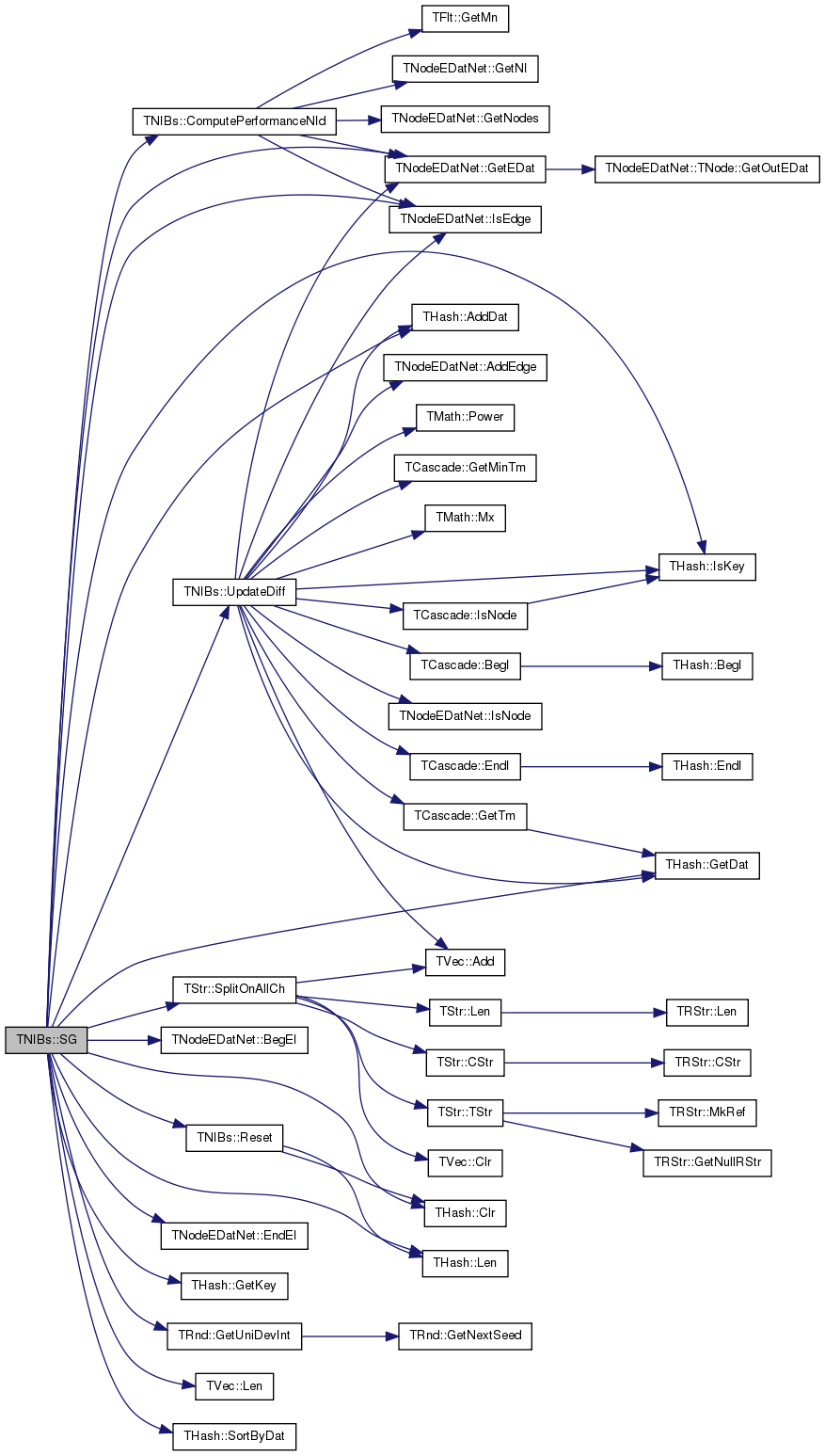
| void TNIBs::SortNodeNmByVol | ( | const bool & | asc = false | ) | [inline] |
Definition at line 219 of file cascdynetinf.h.
References NodeNmH, and THash< TKey, TDat, THashFunc >::SortByDat().

| void TNIBs::UpdateDiff | ( | const TOptMethod & | OptMethod, |
| const int & | NId, | ||
| TCascade & | Cascade, | ||
| TIntPrV & | AlphasToUpdate, | ||
| const double & | CurrentTime = TFlt::Mx |
||
| ) |
Definition at line 721 of file cascdynetinf.cpp.
References TVec< TVal, TSizeTy >::Add(), THash< TKey, TDat, THashFunc >::AddDat(), TNodeEDatNet< TNodeData, TEdgeData >::AddEdge(), AveDiffAlphas, TCascade::BegI(), Delta, TCascade::EndI(), EXP, THash< TKey, TDat, THashFunc >::GetDat(), TNodeEDatNet< TNodeData, TEdgeData >::GetEDat(), TCascade::GetMinTm(), TCascade::GetTm(), IAssert, InferredNetwork, InitAlpha, TNodeEDatNet< TNodeData, TEdgeData >::IsEdge(), THash< TKey, TDat, THashFunc >::IsKey(), TCascade::IsNode(), TNodeEDatNet< TNodeData, TEdgeData >::IsNode(), Model, TMath::Mx(), OBSG, OEBSG, OESG, OFG, OSG, POW, TMath::Power(), RAY, and Window.
Referenced by BSG(), FG(), and SG().
{
IAssert(InferredNetwork.IsNode(NId));
double sum = 0.0;
// we assume cascade is sorted & iterator returns in sorted order
if (Cascade.IsNode(NId) && Cascade.GetTm(NId) <= CurrentTime) {
for (THash<TInt, THitInfo>::TIter NI = Cascade.BegI(); NI < Cascade.EndI(); NI++) {
// consider only nodes that are earlier in time
if ( (Cascade.GetTm(NId)<=NI.GetDat().Tm) ||
(Cascade.GetTm(NId)-Delta<=NI.GetDat().Tm && Model==POW)
) { break; }
TIntPr Pair(NI.GetKey(), NId);
// if edge/alpha doesn't exist, create
if (!InferredNetwork.IsEdge(Pair.Val1, Pair.Val2)) { InferredNetwork.AddEdge(Pair.Val1, Pair.Val2, TFltFltH()); }
if (!InferredNetwork.GetEDat(Pair.Val1, Pair.Val2).IsKey(CurrentTime)) {
InferredNetwork.GetEDat(Pair.Val1, Pair.Val2).AddDat(CurrentTime) = InitAlpha;
}
switch(Model) {
case EXP: // exponential
sum += InferredNetwork.GetEDat(Pair.Val1, Pair.Val2).GetDat(CurrentTime).Val;
break;
case POW: // powerlaw
sum += InferredNetwork.GetEDat(Pair.Val1, Pair.Val2).GetDat(CurrentTime).Val/(Cascade.GetTm(NId)-NI.GetDat().Tm);
break;
case RAY: // rayleigh
sum += InferredNetwork.GetEDat(Pair.Val1, Pair.Val2).GetDat(CurrentTime).Val*(Cascade.GetTm(NId)-NI.GetDat().Tm);
break;
default:
sum = 0.0;
}
}
}
// we assume cascade is sorted & iterator returns in sorted order
for (THash<TInt, THitInfo>::TIter NI = Cascade.BegI(); NI < Cascade.EndI(); NI++) {
// only consider nodes that are earlier in time if node belongs to the cascade
if ( Cascade.IsNode(NId) && (Cascade.GetTm(NId)<=NI.GetDat().Tm ||
(Cascade.GetTm(NId)-Delta<=NI.GetDat().Tm && Model==POW))
) { break; }
// consider infected nodes up to CurrentTime
if (NI.GetDat().Tm > CurrentTime) { break; }
TIntPr Pair(NI.GetKey(), NId); // potential edge
double val = 0.0;
if (Cascade.IsNode(NId) && Cascade.GetTm(NId) <= CurrentTime) {
IAssert((Cascade.GetTm(NId) - NI.GetDat().Tm) > 0.0);
switch(Model) { // compute gradients for infected
case EXP: // exponential
val = (Cascade.GetTm(NId) - NI.GetDat().Tm) - 1.0/sum;
break;
case POW: // powerlaw
val = log((Cascade.GetTm(NId) - NI.GetDat().Tm)/Delta) - 1.0/((Cascade.GetTm(NId)-NI.GetDat().Tm)*sum);
break;
case RAY: // rayleigh
val = TMath::Power(Cascade.GetTm(NId)-NI.GetDat().Tm, 2.0)/2.0 - (Cascade.GetTm(NId)-NI.GetDat().Tm)/sum;
break;
default:
val = 0.0;
}
} else { // compute gradients for non infected
IAssert((CurrentTime - NI.GetDat().Tm) >= 0.0);
switch(Model) {
case EXP: // exponential
val = (CurrentTime-NI.GetDat().Tm);
// if every cascade was recorded up to a maximum Window cut-off
if ( (Window > -1) && (CurrentTime-Cascade.GetMinTm() > Window) ) { val = (Cascade.GetMinTm()+Window-NI.GetDat().Tm); }
break;
case POW: // power-law
val = TMath::Mx(log((CurrentTime-NI.GetDat().Tm)/Delta), 0.0);
// if every cascade was recorded up to a maximum Window cut-off
if ( (Window > -1) && (CurrentTime-Cascade.GetMinTm() > Window) ) { val = TMath::Mx(log((Cascade.GetMinTm()+Window-NI.GetDat().Tm)/Delta), 0.0); }
break;
case RAY: // rayleigh
val = TMath::Power(CurrentTime-NI.GetDat().Tm,2.0)/2.0;
// if every cascade was recorded up to a maximum Window cut-off
if ( (Window > -1) && (CurrentTime-Cascade.GetMinTm() > Window) ) { val = TMath::Power(Cascade.GetMinTm()+Window-NI.GetDat().Tm,2.0)/2.0; }
break;
default:
val = 0.0;
}
}
if (!AveDiffAlphas.IsKey(Pair.Val1)) { AveDiffAlphas.AddDat(Pair.Val1) = 0.0; }
switch (OptMethod) {
case OBSG:
case OEBSG:
case OFG:
// update stochastic average gradient (based on batch for OBSG and OEBSG and based on all cascades for FG)
AveDiffAlphas.GetDat(Pair.Val1) += val;
break;
case OSG:
case OESG:
// update stochastic gradient (we use a single gradient due to current cascade)
AveDiffAlphas.GetDat(Pair.Val1) = val;
default:
break;
}
AlphasToUpdate.Add(Pair);
}
return;
}
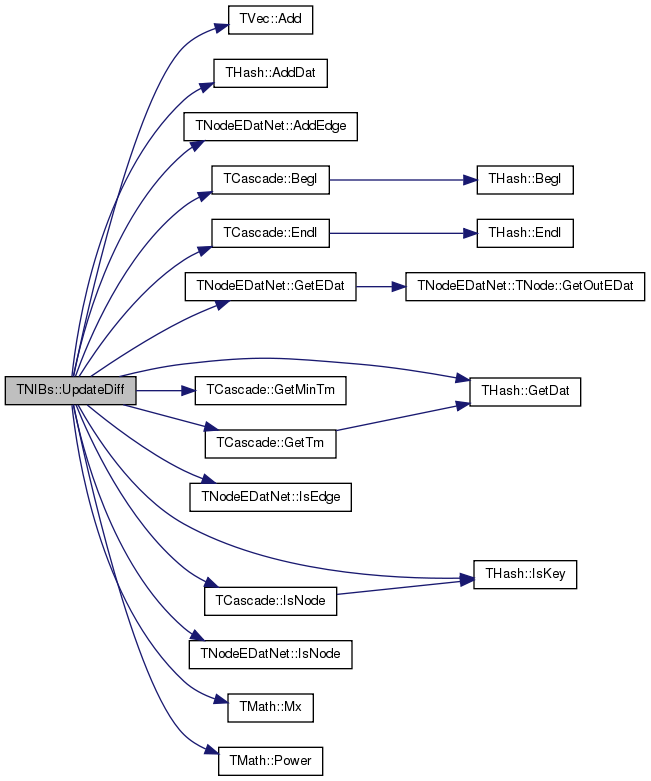
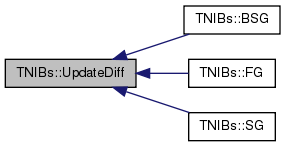
Definition at line 170 of file cascdynetinf.h.
Referenced by ComputePerformanceNId(), and Init().
Definition at line 153 of file cascdynetinf.h.
Referenced by SetAging(), and SG().
Definition at line 162 of file cascdynetinf.h.
Referenced by BSG(), FG(), Reset(), SG(), and UpdateDiff().
Definition at line 135 of file cascdynetinf.h.
Referenced by GetCascadeId().
Definition at line 132 of file cascdynetinf.h.
Referenced by AddCasc(), BSG(), FG(), GetCasc(), GetCascs(), IsCascade(), Save(), SaveCascades(), and SG().
Definition at line 138 of file cascdynetinf.h.
Referenced by Save().
Definition at line 150 of file cascdynetinf.h.
Referenced by GenCascade(), SetDelta(), and UpdateDiff().
Definition at line 163 of file cascdynetinf.h.
Referenced by Reset().
Definition at line 134 of file cascdynetinf.h.
Referenced by AddDomainNm(), GetDomainId(), IsDomainNm(), LoadGroundTruthNodesTxt(), LoadGroundTruthTxt(), LoadInferredNodesTxt(), and LoadInferredTxt().
Definition at line 153 of file cascdynetinf.h.
Referenced by BSG(), FG(), SetGamma(), and SG().
Definition at line 158 of file cascdynetinf.h.
Referenced by BSG(), ComputePerformanceNId(), FG(), GetInferredGraphAtT(), GetInferredNetworkAtT(), GetNodes(), Init(), LabelBurstAutomaton(), LoadInferredNodesTxt(), LoadInferredTxt(), Save(), SaveInferred(), SaveInferredEdges(), SaveInferredPajek(), SG(), and UpdateDiff().
Definition at line 155 of file cascdynetinf.h.
Referenced by SetInitAlpha(), and UpdateDiff().
Definition at line 150 of file cascdynetinf.h.
Referenced by SetK().
Definition at line 170 of file cascdynetinf.h.
Referenced by ComputePerformanceNId(), and Init().
Definition at line 155 of file cascdynetinf.h.
Referenced by BSG(), ComputePerformanceNId(), FG(), SaveGroundTruthPajek(), SaveInferred(), SaveInferredEdges(), SaveInferredPajek(), SetMaxAlpha(), and SG().
Definition at line 155 of file cascdynetinf.h.
Referenced by ComputePerformanceNId(), GetGroundTruthGraphAtT(), GetGroundTruthNetworkAtT(), GetInferredGraphAtT(), GetInferredNetworkAtT(), LabelBurstAutomaton(), SaveGroundTruthPajek(), SaveInferred(), SaveInferredEdges(), SaveInferredPajek(), and SetMinAlpha().
Definition at line 144 of file cascdynetinf.h.
Referenced by GenCascade(), LoadCascadesTxt(), SetModel(), TNIBs(), and UpdateDiff().
Definition at line 170 of file cascdynetinf.h.
Referenced by ComputePerformanceNId(), and Init().
Definition at line 141 of file cascdynetinf.h.
Referenced by ComputePerformanceNId(), GenCascade(), GetGroundTruthGraphAtT(), GetGroundTruthNetworkAtT(), LabelBurstAutomaton(), LoadGroundTruthNodesTxt(), LoadGroundTruthTxt(), SaveGroundTruth(), and SaveGroundTruthPajek().
Definition at line 133 of file cascdynetinf.h.
Referenced by AddNodeNm(), GetGroundTruthGraphAtT(), GetGroundTruthNetworkAtT(), GetInferredGraphAtT(), GetInferredNetworkAtT(), GetNodeInfo(), GetNodeNm(), Init(), IsNodeNm(), Save(), SaveCascades(), SaveGroundTruth(), SaveGroundTruthPajek(), SaveInferred(), SaveInferredEdges(), SaveInferredPajek(), SaveSites(), and SortNodeNmByVol().
Definition at line 169 of file cascdynetinf.h.
Referenced by ComputePerformanceNId(), and Init().
Definition at line 154 of file cascdynetinf.h.
Referenced by BSG(), FG(), SetRegularizer(), and SG().
Definition at line 166 of file cascdynetinf.h.
Referenced by Reset().
Definition at line 155 of file cascdynetinf.h.
Referenced by BSG(), FG(), SetTolerance(), and SG().
Definition at line 159 of file cascdynetinf.h.
Definition at line 147 of file cascdynetinf.h.
Referenced by GenCascade(), and SetTotalTime().
Definition at line 147 of file cascdynetinf.h.
Referenced by GenCascade(), SetWindow(), and UpdateDiff().